Paul van Yperen's Blog, page 260
September 7, 2018
Photo by Massaglia
Ercole Massaglia (1890-1941) was an Italian professional (studio) photographer. He signed his photos with “Massaglia, Torino”. Among them were many portraits of actors and actresses of the Italian stage and cinema as well as the Italian aristocracy and upperclass.

Tatiana Pavlova . Italian postcard, no. 106. Photo: Massaglia, Torino.

Tatiana Pavlova . Italian postcard, no. 107. Photo: Massaglia, Torino. Collection: Didier Hanson.
Russian actress Tatiana (or Tatyana) Pavlova (1893-1975) left Moscow after the revolution and found film work in the silent Italian cinema. Later she became an innovating stage director.
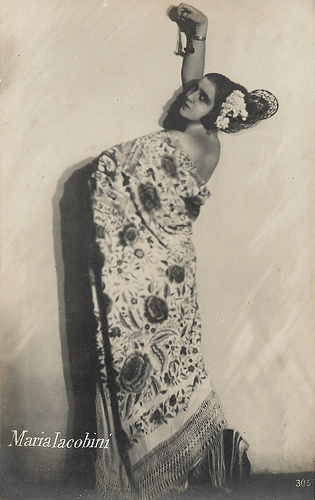
Maria Jacobini . Italian postcard by Ed. Ballerini & Fratini Co., Firenze, no. 305. Photo: Massaglia, Torino.
Italian diva Maria Jacobini (1892-1944) in her outfit for the film Amore rosso (Gennaro Righelli, 1921), set in Spain.
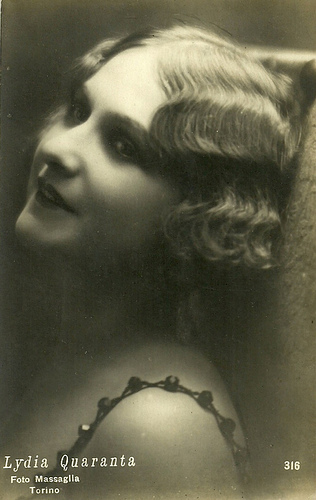
Lydia Quaranta . Italian postcard, no. 316. Photo: Massaglia, Torino.
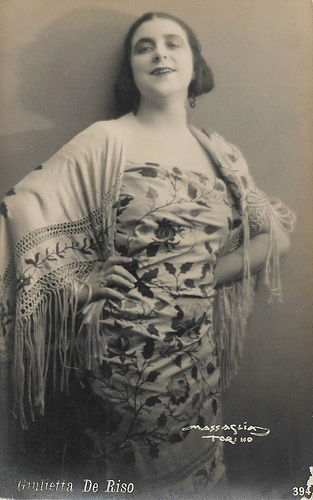
Giulietta De Riso. Italian postcard by Ed. Ballerini & Fratini Co., Firenze, no. 394. Photo: Massaglia, Torino.
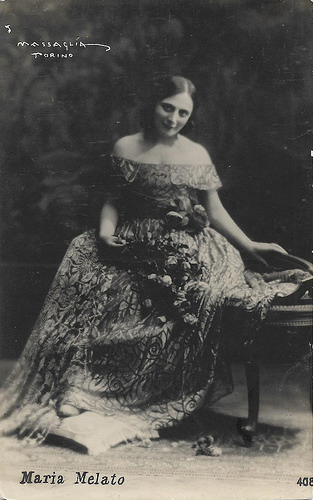
Maria Melato. Italian postcard, no. 408. Photo: Massaglia, Torino.
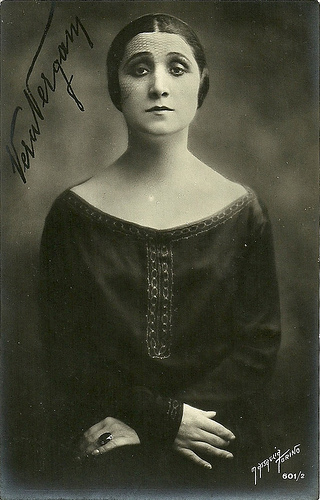
Vera Vergani . Italian postcard, no. 601/2. Photo: Massaglia, Torino.
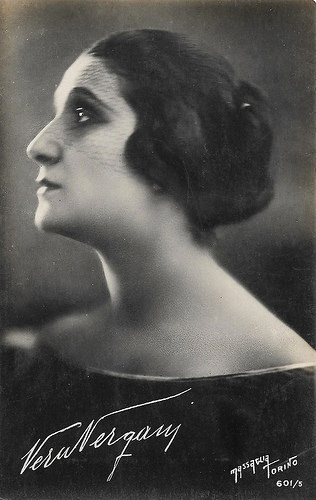
Vera Vergani . Italian postcard by Ed. Ballerini & Fratini, Firenze, no. 601/5. Photo: Massaglia, Torino.
Supplier of the Royal House of Savoy
Ercole Massaglia was born in Asti on 2 July 1890. His family emigrated to Corfu in 1902, but he returned to Turin in 1915, during the First World War, possibly because of Italy joining the Allies.
He opened a photo studio in Via Cernaia 34 in Turin. The Turinese photographic magazine Luci e Ombre, founded in 1922 by the Gruppo piemontese di fotografia artistica, published some of his photos in the years 1923 to 1929 and in 1931.
Massaglia took part in the first International Exhibition of Photography, Optics and Cinematography of 1923 in Turin with some images of actress Paola Borboni and was awarded with an honorary diploma of merit and a gold medal.
In his studio the most famous figures of culture, politics and industry of the time were immortalised, such as Crown Prince Umberto and Princess Jolanda of Savoy, resulting in the text "Supplier of the Royal House of Savoy" on the backs of his pictures.
But also the stage actors such Paola Borboni , Dina Galli , Lydia Quaranta , Vera Vergani , Giulietta De Riso, Gianfranco Giachetti and Annibale Betrone , the painter Giacomo Grosso and the sculptor Vincenzo Gemito were portrayed by Massaglia.
In 1924 he won a 100 lire award for 5 years, for the Professional School of Photography and Optics "Teofilo Rossi". In that same year he was nominated Knight of the Crown of Italy and vice president of the Union of Professional Photographers of Turin. He also won a gold medal "Gevaert" and a "Callegari".
In 1927 two of his images, including the portrait of Cesare Schiaparelli, were published in the Second Yearbook of the Subalpine Photographic Society. In the Corriere Fotografico of December 1928 an article reappeared from Il Nazionale, in which a profile of Ercole Massaglia was traced.
This article accurately described his artistic skills as a portraitist, in particular, and the modernity and efficiency of his studio. In those years, it was considered one of the most avant-garde-like studios in Italy, the only one to own certain machines like the Super-Ego of ing. Bianchi from Milan. In 1931 Massaglia took part in the First Experimental Exhibition of Futurist Photography, held in Turin.
Cavaliere Ercole Massaglia died in Turin on 29 September 1941.
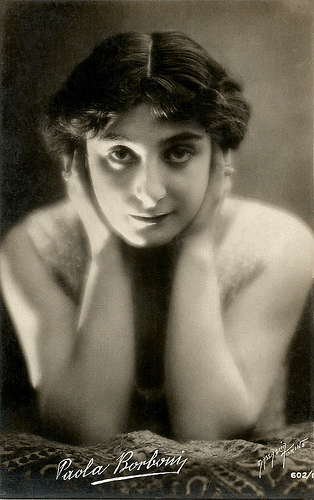
Paola Borboni . Italian postcard by G. Ballerini & Co., Firenze, no. 602/1. Photo: Massaglia, Torino.

Paola Borboni . Italian postcard by G. Ballerini & Co., Firenze, no. 602/3. Photo: Massaglia, Torino.
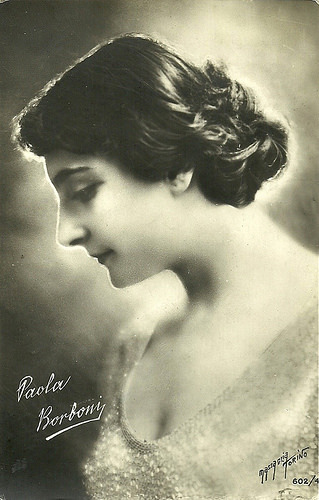
Paola Borboni . Italian postcard by G. Ballerini & Co., Firenze, no. 602/4. Photo: Massaglia, Torino.
Paola Borboni (1900-1995) was one of the greatest stage actresses of Italy. She also played in many films. She was often heard on the radio and seen in television, but her true passion was the stage.
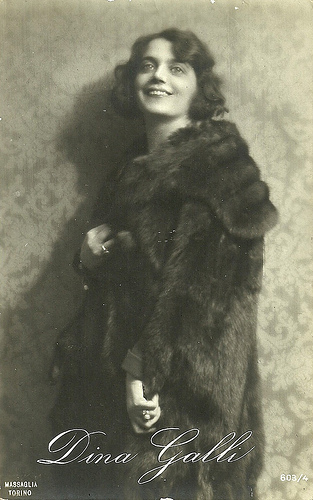
Dina Galli . Italian postcard by G. Ballerini & Co., Firenze, no. 603/4. Photo: Massaglia, Torino.
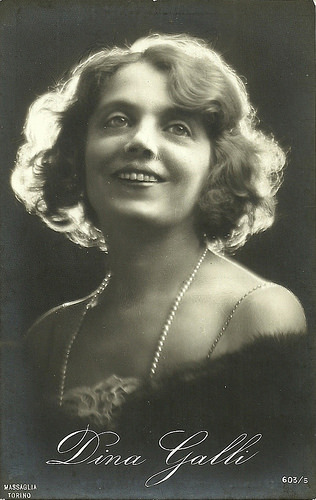
Dina Galli . Italian postcard by G. Ballerini & Co., Firenze, no. 603/5. Photo: Massaglia, Torino.
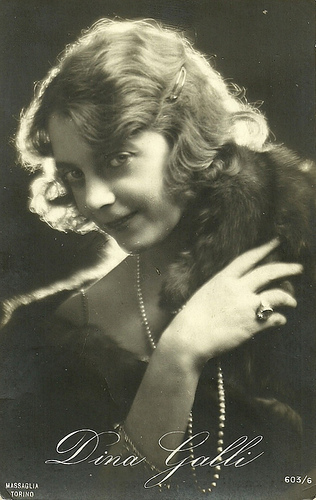
Dina Galli . Italian postcard by G. Ballerini & Co., Firenze, no. 603/6. Photo: Massaglia, Torino.
Dina Galli (1877-1951) was a classic Italian comedienne who also performed in Italian silent and sound cinema.
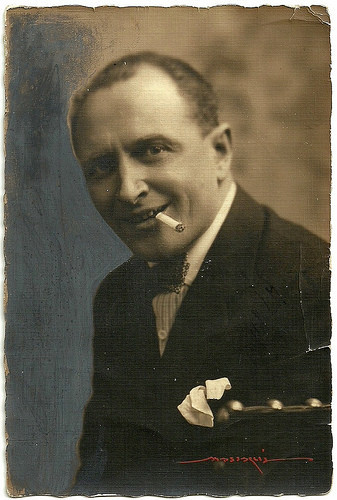
Annibale Betrone . Italian postcard. Photo: Massaglia, Torino.
Source: Comune di Torino (Italian).

Tatiana Pavlova . Italian postcard, no. 106. Photo: Massaglia, Torino.

Tatiana Pavlova . Italian postcard, no. 107. Photo: Massaglia, Torino. Collection: Didier Hanson.
Russian actress Tatiana (or Tatyana) Pavlova (1893-1975) left Moscow after the revolution and found film work in the silent Italian cinema. Later she became an innovating stage director.

Maria Jacobini . Italian postcard by Ed. Ballerini & Fratini Co., Firenze, no. 305. Photo: Massaglia, Torino.
Italian diva Maria Jacobini (1892-1944) in her outfit for the film Amore rosso (Gennaro Righelli, 1921), set in Spain.

Lydia Quaranta . Italian postcard, no. 316. Photo: Massaglia, Torino.

Giulietta De Riso. Italian postcard by Ed. Ballerini & Fratini Co., Firenze, no. 394. Photo: Massaglia, Torino.

Maria Melato. Italian postcard, no. 408. Photo: Massaglia, Torino.

Vera Vergani . Italian postcard, no. 601/2. Photo: Massaglia, Torino.

Vera Vergani . Italian postcard by Ed. Ballerini & Fratini, Firenze, no. 601/5. Photo: Massaglia, Torino.
Supplier of the Royal House of Savoy
Ercole Massaglia was born in Asti on 2 July 1890. His family emigrated to Corfu in 1902, but he returned to Turin in 1915, during the First World War, possibly because of Italy joining the Allies.
He opened a photo studio in Via Cernaia 34 in Turin. The Turinese photographic magazine Luci e Ombre, founded in 1922 by the Gruppo piemontese di fotografia artistica, published some of his photos in the years 1923 to 1929 and in 1931.
Massaglia took part in the first International Exhibition of Photography, Optics and Cinematography of 1923 in Turin with some images of actress Paola Borboni and was awarded with an honorary diploma of merit and a gold medal.
In his studio the most famous figures of culture, politics and industry of the time were immortalised, such as Crown Prince Umberto and Princess Jolanda of Savoy, resulting in the text "Supplier of the Royal House of Savoy" on the backs of his pictures.
But also the stage actors such Paola Borboni , Dina Galli , Lydia Quaranta , Vera Vergani , Giulietta De Riso, Gianfranco Giachetti and Annibale Betrone , the painter Giacomo Grosso and the sculptor Vincenzo Gemito were portrayed by Massaglia.
In 1924 he won a 100 lire award for 5 years, for the Professional School of Photography and Optics "Teofilo Rossi". In that same year he was nominated Knight of the Crown of Italy and vice president of the Union of Professional Photographers of Turin. He also won a gold medal "Gevaert" and a "Callegari".
In 1927 two of his images, including the portrait of Cesare Schiaparelli, were published in the Second Yearbook of the Subalpine Photographic Society. In the Corriere Fotografico of December 1928 an article reappeared from Il Nazionale, in which a profile of Ercole Massaglia was traced.
This article accurately described his artistic skills as a portraitist, in particular, and the modernity and efficiency of his studio. In those years, it was considered one of the most avant-garde-like studios in Italy, the only one to own certain machines like the Super-Ego of ing. Bianchi from Milan. In 1931 Massaglia took part in the First Experimental Exhibition of Futurist Photography, held in Turin.
Cavaliere Ercole Massaglia died in Turin on 29 September 1941.

Paola Borboni . Italian postcard by G. Ballerini & Co., Firenze, no. 602/1. Photo: Massaglia, Torino.

Paola Borboni . Italian postcard by G. Ballerini & Co., Firenze, no. 602/3. Photo: Massaglia, Torino.

Paola Borboni . Italian postcard by G. Ballerini & Co., Firenze, no. 602/4. Photo: Massaglia, Torino.
Paola Borboni (1900-1995) was one of the greatest stage actresses of Italy. She also played in many films. She was often heard on the radio and seen in television, but her true passion was the stage.

Dina Galli . Italian postcard by G. Ballerini & Co., Firenze, no. 603/4. Photo: Massaglia, Torino.

Dina Galli . Italian postcard by G. Ballerini & Co., Firenze, no. 603/5. Photo: Massaglia, Torino.

Dina Galli . Italian postcard by G. Ballerini & Co., Firenze, no. 603/6. Photo: Massaglia, Torino.
Dina Galli (1877-1951) was a classic Italian comedienne who also performed in Italian silent and sound cinema.

Annibale Betrone . Italian postcard. Photo: Massaglia, Torino.
Source: Comune di Torino (Italian).
Published on September 07, 2018 22:00
September 6, 2018
Michèle Mercier
Entrancing, luscious-lipped Michèle Mercier (1939) worked with such famous directors as François Truffaut, Jean-Pierre Melville, and Mario Monicelli. And although she appeared in more than fifty films she will always be best known as seductive Angélique, ‘the Marquise of the Angels’. This star making role proved to be a blessing but also a curse.
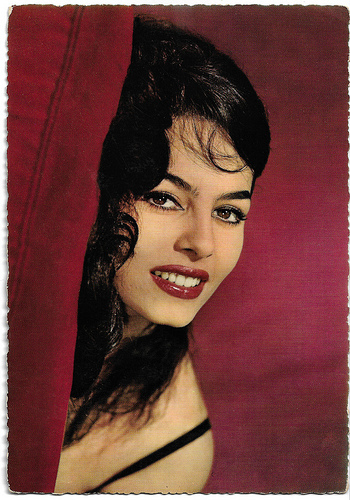
German postcard by Krüger, no. 902/33. Photo: Sam Lévin.
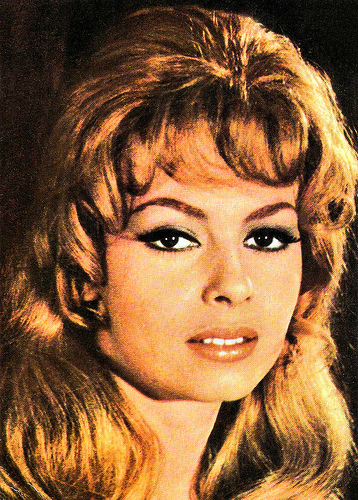
Vintage card. Photo: publicity still for Angélique, marquise des anges/Angélique (Bernard Borderie, 1964).
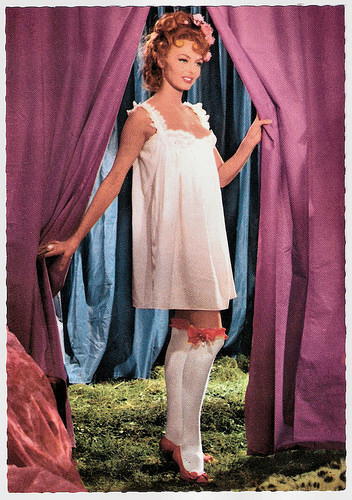
West-German postcard by ISV, no. H-137. Photo: publicity still for Angelique et le roy/Angélique and the King (Bernard Borderie, 1965).
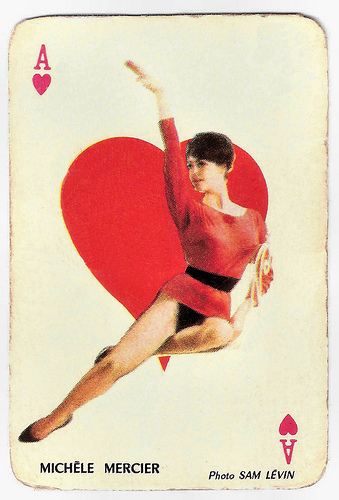
Small French playing card. Photo: Sam Lévin.
Petit Rat
Michèle Mercier was born as Jocelyne Yvonne Renée Mercier in Nice (France) in 1939, the oldest daughter of a French pharmacist father and an Italian mother.
She initially wanted to be a dancer. She studied dancing and at 8 years she became a 'petit rat' (little chorus girl) at the Opera de Nice.
At 15, she played a small part in the film J'avais sept filles/I Have Seven Daughters (Jean Boyer, 1954) starring Maurice Chevalier , who predicted her a successful career.
At 17, she moved to Paris, and studied dance with the company Ballets de la tour Eiffel under the direction of Roland Petit. At the same time she followed drama classes with Solange Sicard. After a stay in London, she had her debut in the theatre.
When she went to her parents for a holiday, she met director Denys de La Patellière, who was filming Retour de manivelle/There's Always a Price Tag (1957) in Nice. He gave her a role – as the chambermaid Jeanne.
Her birth name seemed too long and old-fashioned for a film career, so she adopted the name Michèle. This was the name of her younger sister, who had died at the age of five from typhoid fever, and also of the star of Retour de manivelle, the great actress Michèle Morgan .
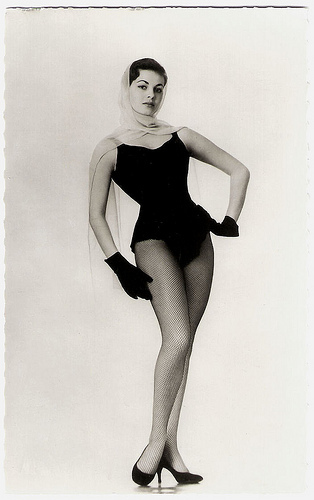
French postcard by Editions P.I., Paris, no. 937. Offered by Les Carbones Korès 'Carboplane'. Photo: Sam Lévin.
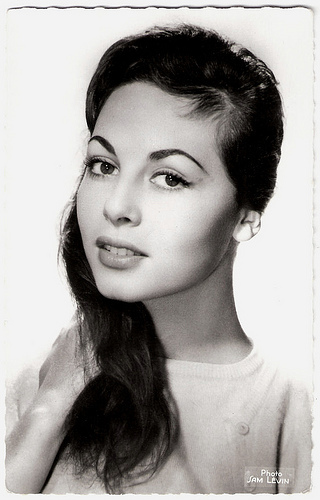
French postcard by Editions du Globe, Paris, no. 673. Photo: Sam Lévin.
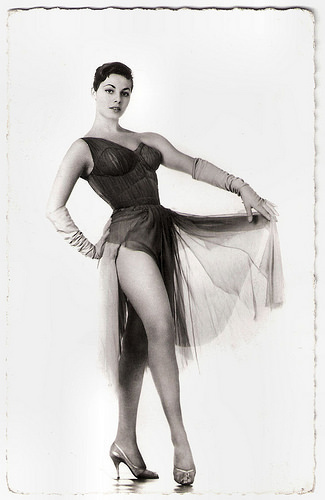
French postcard by Editions du Globe, Paris, no. 728. Photo: Sam Lévin.
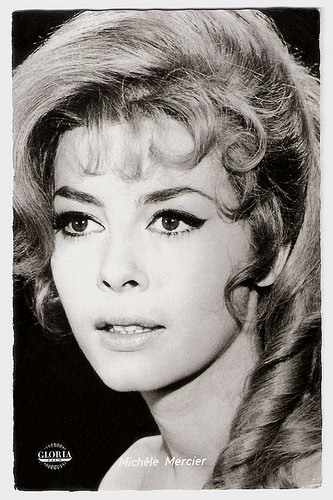
German postcard by Kolibri-Verlag, Minden/Westf., no. 2420. Photo: Gloria-Film. Publicity still for Angélique, marquise des anges/Angélique (Bernard Borderie, 1964).

West-German postcard by Filmbilder-Vertrieb Ernst Freihoff, Essen. Photo: Gloria Film. Publicity still for Angélique, marquise des anges/Angélique (Bernard Borderie, 1964).
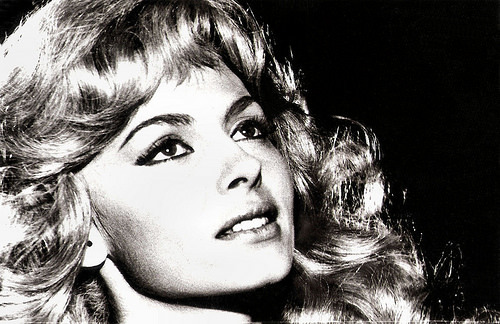
Romanian postcard by Casa Filmului Acin. Photo: publicity still for Angélique, marquise des anges/Angélique (Bernard Borderie, 1964).
Shoot the Pianist
Michèle Mercier was noticed by Léonide Moguy, who offered her the leading part in his film Donnez-moi ma chance/Give Me My Chance (1958).
Robert Lamoureux made her the leading lady of La brune que voilà/There Is the Brunette – both in the theatre (1958) and on screen (1960). In 1959 she was invited to go to Hollywood but she quickly returned to Europe and became a star in Italy.
She played parts in such European coproductions as Ein Engel auf Erden/Angel on Earth (Géza von Radványi, 1959) co-starring with Romy Schneider and Henri Vidal , and Le Notti di Lucrezia Borgia/The Nights of Lucretia Borgia (Serge Grieco, 1959) starring Belinda Lee .
In Tirez sur le pianist/Shoot the Pianist (François Truffaut, 1960) she played the part of a prostitute next to Charles Aznavour . Then followed Aimez-vous Brahms/Goodbye Again (Anatole Litvak, 1961) starring Ingrid Bergman.
She continued her career in France in Symphonie pour un massacre/Symphony for a Massacre (Jacques Deray, 1963), and L’aine des Ferchaux/An Honorable Young Man
(Jean Pierre Melville, 1963) with Jean-Paul Belmondo .
She sometimes worked in England, but more often in Italy. There she appeared in such films as Gli anni ruggenti/Roaring Years (Luigi Zampa, 1962), I Mostri/The Monsters (Dino Risi, 1963), and Alta infedeltà/High Infidelity (Mario Monicelli, 1964).
She also starred in two Mario Bava films: Le Meraviglie di Aladino/The Wonders of Aladdin (1961) and I tre volti della paura/The Three Faces of Fear (1963), in the sketch The Telephone.
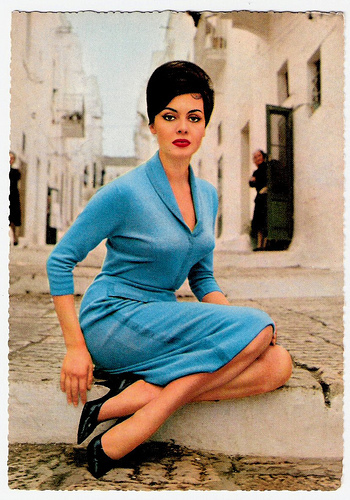
German postcard by Krüger, no. 902/127.
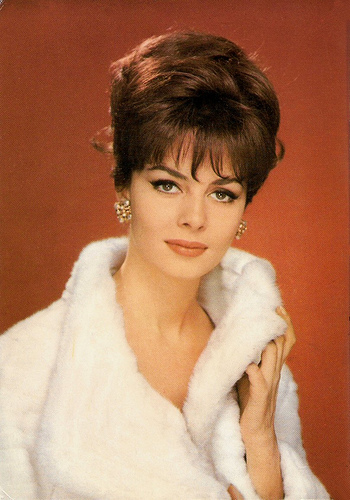
French postcard by E.D.U.G., no. 472. Photo: Sam Lévin.
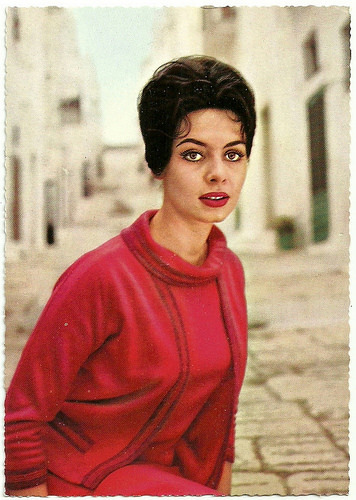
Vintage postcard.
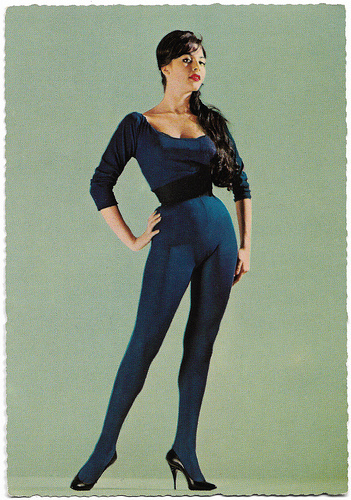
German postcard by Krüger, no. 902/32. Photo: Sam Lévin.
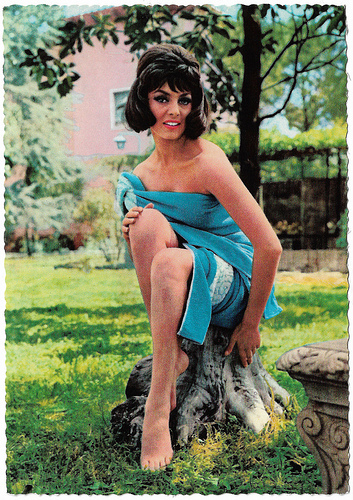
German postcard by Krüger, no. 902/295. Photo: Georg Michalke.
Angélique
Michèle Mercier needed a role which could make her a real star of the French cinema. In 1963 she got her chance, when producer Francis Cosne decided to make a film of the sensational novel Angélique, by Anne & Serge Golon.
Cosne considered Brigitte Bardot (refused), Annette Vadim (too unknown), Catherine Deneuve (too pale), Jane Fonda (too American), and Virna Lisi (busy in America) for the part, but the actress he most seriously considered was Marina Vlady .
Vlady almost signed a contract, but Mercier won the role after trying out for it. She did not appreciate this very much since she was being treated like a beginner at a time when she was already well-known in Italy. At the time she was contacted to play Angélique, she had already acted in over twenty films.
Angélique, marquise des anges/Angélique (Bernard Borderie, 1964) enjoyed an astonishing success. During four years Mercier made a cycle of five Angélique films.
However the role of ‘the Marquise of the Angels’ proved to be both a blessing and a curse, as Ivar Kümnik writes at IMDb : "It catapulted her to almost instant stardom, rivalling Brigitte Bardot in celebrity and popularity", but the character of Angélique overshadowed all other aspects of her career. By the end of the 1960s, the names Angélique and Michèle Mercier were synonymous.
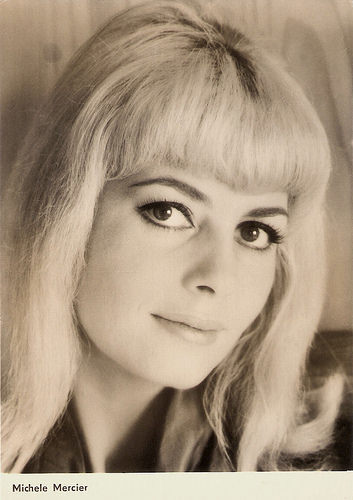
East-German postcard by VEB Progress Film-Vertrieb, no. 3181, 1968. Photo: Unifrance. Publicity still for I nostri mariti/Our Husbands (Luigi Filippo D'Amico, Dino Risi, Luigi Zampa, 1966).
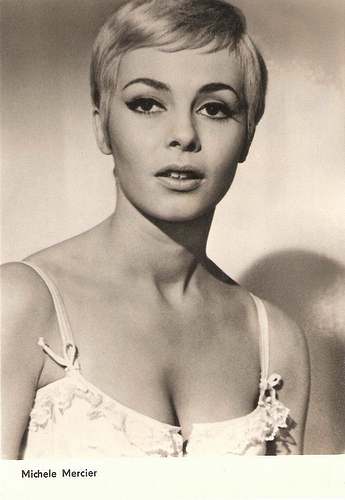
East-German postcard by VEB Progress, no. 2912, 1967.
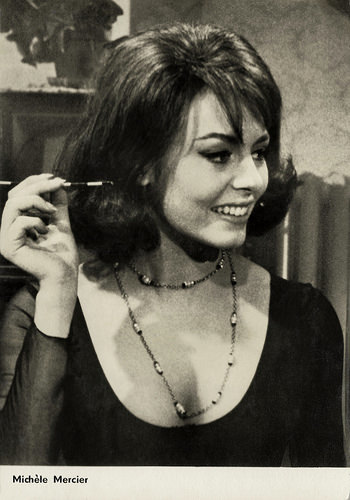
East-German card by VEB Progress Film-Vertrieb, Berlin, no. 3201, 1968. Publicity still for I nostri mariti/Our Husbands (Luigi Filippo D'Amico, Dino Risi, Luigi Zampa, 1966).

East-German postcard by VEB Progress, no. 31/69, 1969. Photo: publicity still for Le tonnerre de Dieu/The Thunder of God (Denys de La Patellière, 1965).
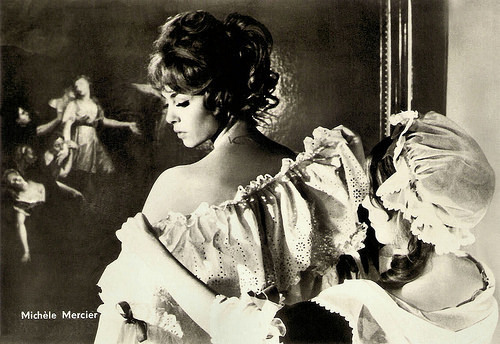
East-German postcard by VEB Progress Film-Vertrieb, Berlin, no. 25/71, 1971. Retail price: 0,20 DM. Photo: Progress.
You Can't Win 'Em All
Michèle Mercier attempted to break free from the Angélique character and accepted roles opposite Jean Gabin in Le tonnère de Dieu/The Thunder of God (Denys de la Patellière, 1965), and opposite Robert Hossein in La Seconde Vérité/The Other Truth (Christian-Jaque, 1966).
Mercier then left France and tried to re-start her career in the United States. She played in You Can't Win 'Em All (Peter Collinson, 1970) with Tony Curtis and Charles Bronson, but unfortunately it was a disaster.
Her private life was disastrous too. She married assistant-director André Smagghe in 1961. Sadly he turned out to be an alcoholic who was eventually hospitalised. They divorced in 1967. After a long relationship she married the well-known racing driver Claude Bourillot in 1970, but he disappeared one day with all her jewels and money, leaving her penniless. They divorced in 1976.
Her other relationships were also disastrous. She claimed that her co-star Vittorio Gassman once tried to rape her, and an Italian Prince N. refused to marry her after many years of courtship. She was also pursued by Bettino Craxi and Silvio Berlusconi.
In 1987 she published her autobiography Angélique a cœur perdu, prefaced by Roger Peyrefitte. She started a publishing house and in 1995, the photobook Merveilleuse Angélique was published. At the end of 1996 her second autobiography was released Angéliquement Votre. Unfortunately her business associate stole from her and she ended up with a large debt.
She confessed in the French newspaper Nice Matin: "I am ruined, I'll be obliged to sell part of my paintings, my furnitures, my properties, my jewels and the costumes of Angélique". After a 14-year interval she returned to the screen in La Rumbera (Piero Vivarelli, 1998).
She returned to the area where she was born, and lived in Cannes. In 2002 another autobiography Je ne suis pas Angélique/I am not Angélique was published.
On TV, she played parts in the Italian series Il Bello delle Donna/The Beauty of Women (Luigi Parisi a.o., 2003) with Stefania Sandrelli and Gabriel Garko, the Russian war series Krasnaya kapella (2004) and the French comedy series Vénus & Apollon/Venus and Apollo (Pascal Lahmani, 2009) with Maria de Medeiros.
In 2011, she returned to the cinema in Celles qui aimaient Richard Wagner/Those Who Love Richard Wagner (Jean-Louis Guillermou, 2011) featuring Jean-François Balmer as the famous composer. In 2013 followed the TV series La Famille Katz/The Katz family (Arnauld Mercadier, 2013), for now her last screen appearance.
In 2006, Michèle Mercier was decorated with the French order of Chevalier dans l'Ordre national des Arts et lettres. In his speech the Minister of the Culture reverted to her "immense popular success" in the mythical series Angélique, in which she personified a "liberated woman, sensual and strong".
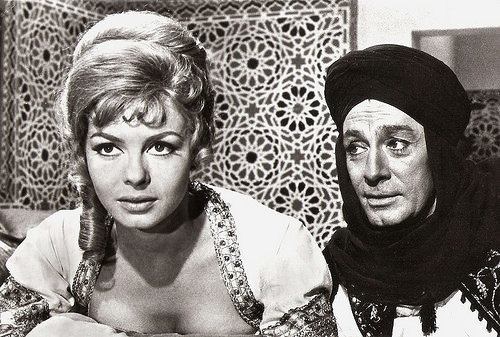
Romanian postcard by Casa Filmului Acin. Photo: publicity still for Angelique et le sultan/Angelique and the sultan (Bernard Borderie, 1966) with Jean-Claude Pascal .

French photo by Francos Film - C.I.C.C. (Paris), Gloria Film (Munich), Fono Roma (Rome). Publicity still for Indomptable Angélique/Untamable Angelique (Bernard Borderie, 1967).
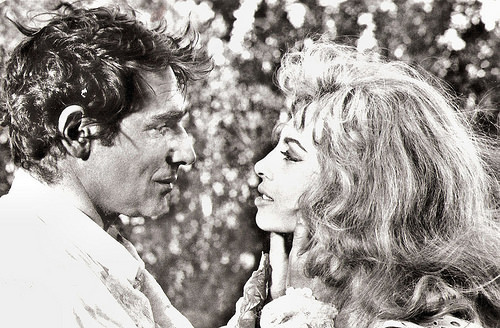
Romanian postcard by Casa Filmului Acin. Photo: publicity still for Indomptable Angelique/Untamable Angélique (Bernard Borderie, 1967) with Robert Hossein .
Trailer of I tre volti della paura/Black Sabbath (1963). Source: Danios12345 (YouTube).
'Mini-trailer' for the film film Une veuve en or/A golden widow (Michel Audiard, 1969). Michèle Mercier sings La Fille Qui Fait Tchic Ti Tchic. Source: Jinoschka (YouTube).
Sources: (IMDb), Wikipedia, Michèle Mercier’s Fansite, and .

German postcard by Krüger, no. 902/33. Photo: Sam Lévin.

Vintage card. Photo: publicity still for Angélique, marquise des anges/Angélique (Bernard Borderie, 1964).

West-German postcard by ISV, no. H-137. Photo: publicity still for Angelique et le roy/Angélique and the King (Bernard Borderie, 1965).

Small French playing card. Photo: Sam Lévin.
Petit Rat
Michèle Mercier was born as Jocelyne Yvonne Renée Mercier in Nice (France) in 1939, the oldest daughter of a French pharmacist father and an Italian mother.
She initially wanted to be a dancer. She studied dancing and at 8 years she became a 'petit rat' (little chorus girl) at the Opera de Nice.
At 15, she played a small part in the film J'avais sept filles/I Have Seven Daughters (Jean Boyer, 1954) starring Maurice Chevalier , who predicted her a successful career.
At 17, she moved to Paris, and studied dance with the company Ballets de la tour Eiffel under the direction of Roland Petit. At the same time she followed drama classes with Solange Sicard. After a stay in London, she had her debut in the theatre.
When she went to her parents for a holiday, she met director Denys de La Patellière, who was filming Retour de manivelle/There's Always a Price Tag (1957) in Nice. He gave her a role – as the chambermaid Jeanne.
Her birth name seemed too long and old-fashioned for a film career, so she adopted the name Michèle. This was the name of her younger sister, who had died at the age of five from typhoid fever, and also of the star of Retour de manivelle, the great actress Michèle Morgan .

French postcard by Editions P.I., Paris, no. 937. Offered by Les Carbones Korès 'Carboplane'. Photo: Sam Lévin.

French postcard by Editions du Globe, Paris, no. 673. Photo: Sam Lévin.

French postcard by Editions du Globe, Paris, no. 728. Photo: Sam Lévin.

German postcard by Kolibri-Verlag, Minden/Westf., no. 2420. Photo: Gloria-Film. Publicity still for Angélique, marquise des anges/Angélique (Bernard Borderie, 1964).

West-German postcard by Filmbilder-Vertrieb Ernst Freihoff, Essen. Photo: Gloria Film. Publicity still for Angélique, marquise des anges/Angélique (Bernard Borderie, 1964).

Romanian postcard by Casa Filmului Acin. Photo: publicity still for Angélique, marquise des anges/Angélique (Bernard Borderie, 1964).
Shoot the Pianist
Michèle Mercier was noticed by Léonide Moguy, who offered her the leading part in his film Donnez-moi ma chance/Give Me My Chance (1958).
Robert Lamoureux made her the leading lady of La brune que voilà/There Is the Brunette – both in the theatre (1958) and on screen (1960). In 1959 she was invited to go to Hollywood but she quickly returned to Europe and became a star in Italy.
She played parts in such European coproductions as Ein Engel auf Erden/Angel on Earth (Géza von Radványi, 1959) co-starring with Romy Schneider and Henri Vidal , and Le Notti di Lucrezia Borgia/The Nights of Lucretia Borgia (Serge Grieco, 1959) starring Belinda Lee .
In Tirez sur le pianist/Shoot the Pianist (François Truffaut, 1960) she played the part of a prostitute next to Charles Aznavour . Then followed Aimez-vous Brahms/Goodbye Again (Anatole Litvak, 1961) starring Ingrid Bergman.
She continued her career in France in Symphonie pour un massacre/Symphony for a Massacre (Jacques Deray, 1963), and L’aine des Ferchaux/An Honorable Young Man
(Jean Pierre Melville, 1963) with Jean-Paul Belmondo .
She sometimes worked in England, but more often in Italy. There she appeared in such films as Gli anni ruggenti/Roaring Years (Luigi Zampa, 1962), I Mostri/The Monsters (Dino Risi, 1963), and Alta infedeltà/High Infidelity (Mario Monicelli, 1964).
She also starred in two Mario Bava films: Le Meraviglie di Aladino/The Wonders of Aladdin (1961) and I tre volti della paura/The Three Faces of Fear (1963), in the sketch The Telephone.

German postcard by Krüger, no. 902/127.

French postcard by E.D.U.G., no. 472. Photo: Sam Lévin.

Vintage postcard.

German postcard by Krüger, no. 902/32. Photo: Sam Lévin.

German postcard by Krüger, no. 902/295. Photo: Georg Michalke.
Angélique
Michèle Mercier needed a role which could make her a real star of the French cinema. In 1963 she got her chance, when producer Francis Cosne decided to make a film of the sensational novel Angélique, by Anne & Serge Golon.
Cosne considered Brigitte Bardot (refused), Annette Vadim (too unknown), Catherine Deneuve (too pale), Jane Fonda (too American), and Virna Lisi (busy in America) for the part, but the actress he most seriously considered was Marina Vlady .
Vlady almost signed a contract, but Mercier won the role after trying out for it. She did not appreciate this very much since she was being treated like a beginner at a time when she was already well-known in Italy. At the time she was contacted to play Angélique, she had already acted in over twenty films.
Angélique, marquise des anges/Angélique (Bernard Borderie, 1964) enjoyed an astonishing success. During four years Mercier made a cycle of five Angélique films.
However the role of ‘the Marquise of the Angels’ proved to be both a blessing and a curse, as Ivar Kümnik writes at IMDb : "It catapulted her to almost instant stardom, rivalling Brigitte Bardot in celebrity and popularity", but the character of Angélique overshadowed all other aspects of her career. By the end of the 1960s, the names Angélique and Michèle Mercier were synonymous.

East-German postcard by VEB Progress Film-Vertrieb, no. 3181, 1968. Photo: Unifrance. Publicity still for I nostri mariti/Our Husbands (Luigi Filippo D'Amico, Dino Risi, Luigi Zampa, 1966).

East-German postcard by VEB Progress, no. 2912, 1967.

East-German card by VEB Progress Film-Vertrieb, Berlin, no. 3201, 1968. Publicity still for I nostri mariti/Our Husbands (Luigi Filippo D'Amico, Dino Risi, Luigi Zampa, 1966).

East-German postcard by VEB Progress, no. 31/69, 1969. Photo: publicity still for Le tonnerre de Dieu/The Thunder of God (Denys de La Patellière, 1965).

East-German postcard by VEB Progress Film-Vertrieb, Berlin, no. 25/71, 1971. Retail price: 0,20 DM. Photo: Progress.
You Can't Win 'Em All
Michèle Mercier attempted to break free from the Angélique character and accepted roles opposite Jean Gabin in Le tonnère de Dieu/The Thunder of God (Denys de la Patellière, 1965), and opposite Robert Hossein in La Seconde Vérité/The Other Truth (Christian-Jaque, 1966).
Mercier then left France and tried to re-start her career in the United States. She played in You Can't Win 'Em All (Peter Collinson, 1970) with Tony Curtis and Charles Bronson, but unfortunately it was a disaster.
Her private life was disastrous too. She married assistant-director André Smagghe in 1961. Sadly he turned out to be an alcoholic who was eventually hospitalised. They divorced in 1967. After a long relationship she married the well-known racing driver Claude Bourillot in 1970, but he disappeared one day with all her jewels and money, leaving her penniless. They divorced in 1976.
Her other relationships were also disastrous. She claimed that her co-star Vittorio Gassman once tried to rape her, and an Italian Prince N. refused to marry her after many years of courtship. She was also pursued by Bettino Craxi and Silvio Berlusconi.
In 1987 she published her autobiography Angélique a cœur perdu, prefaced by Roger Peyrefitte. She started a publishing house and in 1995, the photobook Merveilleuse Angélique was published. At the end of 1996 her second autobiography was released Angéliquement Votre. Unfortunately her business associate stole from her and she ended up with a large debt.
She confessed in the French newspaper Nice Matin: "I am ruined, I'll be obliged to sell part of my paintings, my furnitures, my properties, my jewels and the costumes of Angélique". After a 14-year interval she returned to the screen in La Rumbera (Piero Vivarelli, 1998).
She returned to the area where she was born, and lived in Cannes. In 2002 another autobiography Je ne suis pas Angélique/I am not Angélique was published.
On TV, she played parts in the Italian series Il Bello delle Donna/The Beauty of Women (Luigi Parisi a.o., 2003) with Stefania Sandrelli and Gabriel Garko, the Russian war series Krasnaya kapella (2004) and the French comedy series Vénus & Apollon/Venus and Apollo (Pascal Lahmani, 2009) with Maria de Medeiros.
In 2011, she returned to the cinema in Celles qui aimaient Richard Wagner/Those Who Love Richard Wagner (Jean-Louis Guillermou, 2011) featuring Jean-François Balmer as the famous composer. In 2013 followed the TV series La Famille Katz/The Katz family (Arnauld Mercadier, 2013), for now her last screen appearance.
In 2006, Michèle Mercier was decorated with the French order of Chevalier dans l'Ordre national des Arts et lettres. In his speech the Minister of the Culture reverted to her "immense popular success" in the mythical series Angélique, in which she personified a "liberated woman, sensual and strong".

Romanian postcard by Casa Filmului Acin. Photo: publicity still for Angelique et le sultan/Angelique and the sultan (Bernard Borderie, 1966) with Jean-Claude Pascal .

French photo by Francos Film - C.I.C.C. (Paris), Gloria Film (Munich), Fono Roma (Rome). Publicity still for Indomptable Angélique/Untamable Angelique (Bernard Borderie, 1967).

Romanian postcard by Casa Filmului Acin. Photo: publicity still for Indomptable Angelique/Untamable Angélique (Bernard Borderie, 1967) with Robert Hossein .
Trailer of I tre volti della paura/Black Sabbath (1963). Source: Danios12345 (YouTube).
'Mini-trailer' for the film film Une veuve en or/A golden widow (Michel Audiard, 1969). Michèle Mercier sings La Fille Qui Fait Tchic Ti Tchic. Source: Jinoschka (YouTube).
Sources: (IMDb), Wikipedia, Michèle Mercier’s Fansite, and .
Published on September 06, 2018 22:00
September 5, 2018
Drohende Wolken am Firmament (1919)
The German silent film Drohende Wolken am Firmament/Threatening clouds in the sky (1918) was directed (probably) and written by its star, Fern Andra. It was also produced by her own studio, Fern Andra Atelier. The American actress was one of the most popular film stars of the German cinema in the 1910s and early 1920s.
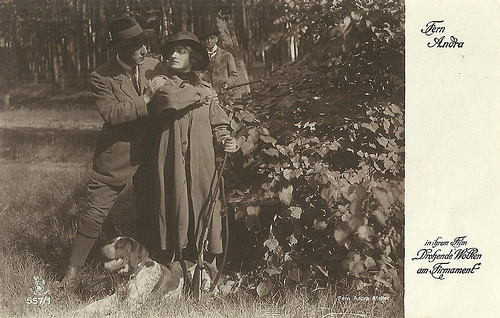
German postcard by Rotophot in the Film Sterne series, no. 557/1. Photo: Fern Andra Atelier. Publicity still for Drohende Wolken am Firmament/Threatening clouds in the sky (Fern Andra, 1918). In the foreground Paul Passarge as Hans and Fern Andra as Fern, in the background Alfred Abel as the husband, doctor Alfred.
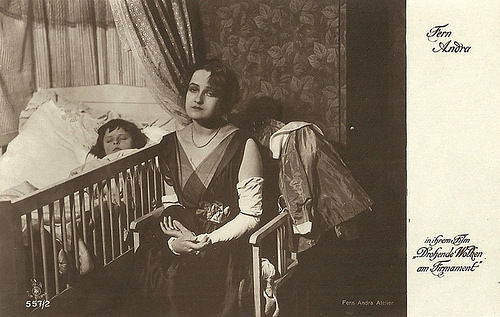
German postcard by Rotophot in the Film Sterne series, no. 557/2. Photo: Fern Andra Atelier. Publicity still of Fern Andra in Drohende Wolken am Firmament/Threatening clouds in the sky (Fern Andra, 1918).
Can he commit adultery without being noticed?
In Drohende Wolken am Firmament/Threatening clouds in the sky, Dr. Alfred ( Alfred Abel ) takes a bet with his friend Hans (Paul Passarge) that he can commit adultery without being noticed. Alfred seems to manage but then he loses his wallet.
Hans finds it and uses it as proof to convince Alfred's wife Fern ( Fern Andra ) to agree with his indecent proposal. Alfred overhears a talk between them and suspects his wife may commit adultery.
The dramatic development in Fern's and Alfred's marriage crisis finds its redemption only when their child is in dire straits. Alfred's operation rescues the child and the couple reconciles.
Drohende Wolken am Firmament was shot during the first half of 1918 in the Fern Andra Filmatelier in Berlin's Chausseestrasse 42. The four-act film was 1170 meters long, passed the censorship in July 1918 and premiered in the following month at the Berlin U.T. Nollendorfplatz.
In Austria, it started on September 13, 1918. The version shown there was at about 1700 meters, significantly longer than the German original version. In the Austrian source Paimann’s Filmlisten one reads: "script and cinematography really good, performance outstanding."
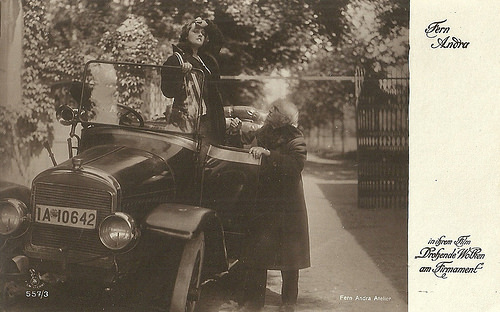
German postcard by Rotophot in the Film Sterne series, no. 557/3. Photo: Fern Andra Atelier. Publicity still of Fern Andra in Drohende Wolken am Firmament/Threatening clouds in the sky (Fern Andra, 1918).

German postcard by Rotophot in the Film Sterne series, no. 557/4. Photo: Fern Andra Atelier. Publicity still of Fern Andra in Drohende Wolken am Firmament/Threatening clouds in the sky (Fern Andra, 1918).
Sources: Wikipedia (German) and IMDb.

German postcard by Rotophot in the Film Sterne series, no. 557/1. Photo: Fern Andra Atelier. Publicity still for Drohende Wolken am Firmament/Threatening clouds in the sky (Fern Andra, 1918). In the foreground Paul Passarge as Hans and Fern Andra as Fern, in the background Alfred Abel as the husband, doctor Alfred.

German postcard by Rotophot in the Film Sterne series, no. 557/2. Photo: Fern Andra Atelier. Publicity still of Fern Andra in Drohende Wolken am Firmament/Threatening clouds in the sky (Fern Andra, 1918).
Can he commit adultery without being noticed?
In Drohende Wolken am Firmament/Threatening clouds in the sky, Dr. Alfred ( Alfred Abel ) takes a bet with his friend Hans (Paul Passarge) that he can commit adultery without being noticed. Alfred seems to manage but then he loses his wallet.
Hans finds it and uses it as proof to convince Alfred's wife Fern ( Fern Andra ) to agree with his indecent proposal. Alfred overhears a talk between them and suspects his wife may commit adultery.
The dramatic development in Fern's and Alfred's marriage crisis finds its redemption only when their child is in dire straits. Alfred's operation rescues the child and the couple reconciles.
Drohende Wolken am Firmament was shot during the first half of 1918 in the Fern Andra Filmatelier in Berlin's Chausseestrasse 42. The four-act film was 1170 meters long, passed the censorship in July 1918 and premiered in the following month at the Berlin U.T. Nollendorfplatz.
In Austria, it started on September 13, 1918. The version shown there was at about 1700 meters, significantly longer than the German original version. In the Austrian source Paimann’s Filmlisten one reads: "script and cinematography really good, performance outstanding."

German postcard by Rotophot in the Film Sterne series, no. 557/3. Photo: Fern Andra Atelier. Publicity still of Fern Andra in Drohende Wolken am Firmament/Threatening clouds in the sky (Fern Andra, 1918).

German postcard by Rotophot in the Film Sterne series, no. 557/4. Photo: Fern Andra Atelier. Publicity still of Fern Andra in Drohende Wolken am Firmament/Threatening clouds in the sky (Fern Andra, 1918).
Sources: Wikipedia (German) and IMDb.
Published on September 05, 2018 22:00
September 4, 2018
Darry Cowl
French comic actor and musician Darry Cowl (1925-2006) appeared in more than 150 films, often as a clown with a chronic stutter. Many of his comedies were not worth his talents, but at the end of his life, he made a glorious come-back and won the César twice.
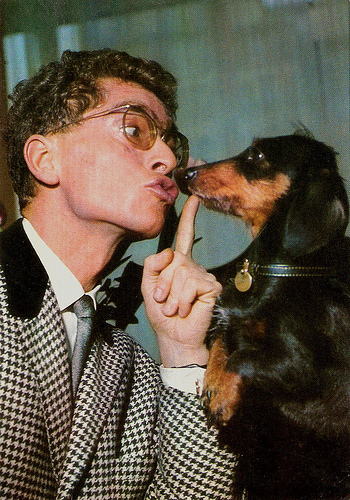
French postcard by Ed. Borde, Bal, no. 106. Photo: Wiezniak / Philips.
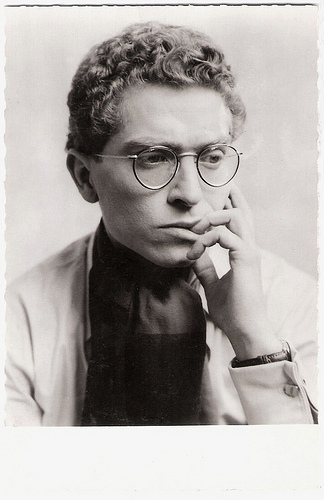
French postcard by Editions P.I., Paris, no. 233 (?). Photo: Sam Lévin.
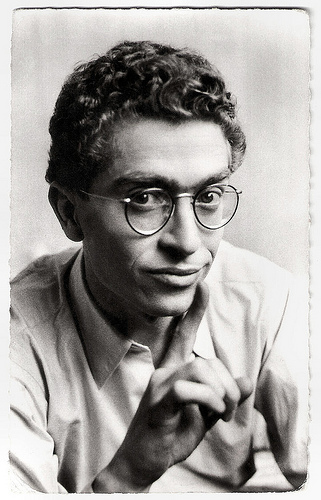
French postcard by Editions du Globe, Paris, no. 743.
Silly ass
Darry Cowl was born as André Darricau in Vittel, France, in 1925. His father was a doctor.
He studied music at the Conservatoire de Paris. After he had finished his studies successfully, he did not chose to work for an orchestra, but became a musical clown in the nightclubs and cabarets of Paris.
He made his film debut in Quatre jours à Paris/Four Days in Paris (André Berthomieu, 1955) with Luis Mariano , and soon appeared in small roles in films like Bonjour sourire/Good Morning Smile (Claude Sautet, 1955), and En effeuillant la marguerite/Mademoiselle Striptease (Marc Allégret, 1956) with Brigitte Bardot .
Director Sacha Guitry cast him twice in Assassins et voleurs/Assassins and Robbers (1957) and in Les Trois font la paire/Three Make a Pair (1957). Cowl decided to focus on film acting.
He gained celebrity status with his role as Antoine Péralou in Le Triporteur/The Tricycle (Jacques Pinoteau, 1957). The stuttering Antoine is a football fanatic, who follows his favourite team from one game to the next madly peddling his tricycle to his various destinations.
Between 1955 and 1965, Cowl played in more than 60 films made by directors like André Berthomieu, Jean Girault and Jacques Pinoteau. He often played the silly ass who stumbles on his lines on purpose.
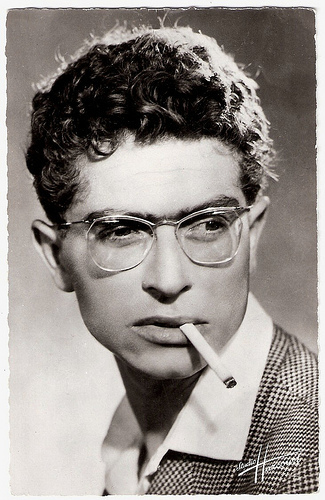
French postcard by Editions du Globe (E.D.U.G.), Paris, no. 700. Photo: Studio Harcourt.
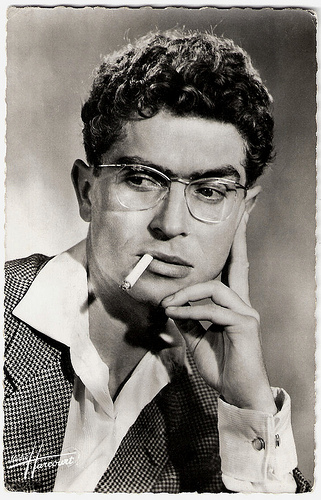
French postcard by Editions du Globe (E.D.U.G.), Paris, no. 716. Photo: Studio Harcourt.
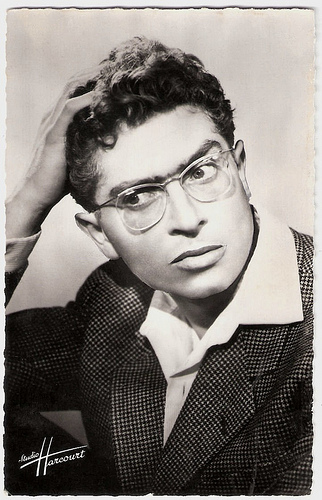
French postcard by Editions du Globe (E.D.U.G.), Paris, no. 680. Photo: Studio Harcourt.
Game Addict
Darry Cowl was a game addict, and he often acted only for the money in films that did not stretch his acting ability. An exception was Archimède, le clochard/The Magnificent Tramp (Gilles Grangier, 1959) in which he appeared opposite the great Jean Gabin .
In 1964, Cowl directed a feature film himself, Jaloux comme un tigre/Jealous as a Tiger (Darry Cowl, 1964). He also appeared in this comedy, wrote the scenario and composed the score. Sadly it was not a success.
He continued to appear in dozens of comedies, including Les tribulations d'un chinois en Chine/Up to His Ears (Philippe de Broca, 1965) and an episode of Les bons vivants/High Lifers (Gilles Grangier, Georges Lautner, 1965).
In 1974 he played Major Archibald in Touche pas à la femme blanche/Don't Touch the White Woman! (Marco Ferreri, 1974) with Catherine Deneuve , the only film he pretended to be proud about. The next decades most of his films were not very interesting.
He wrote three memoirs, Le flambeur (1986) about his passion for the game, Le triporteur se livre (1994) and Mémoires d'un canaillou (2005).
During the 1990s, he appeared in better films like Ville à vendre/City for Sale (Jean-Pierre Mocky, 1992) starring Michel Serrault , and Les misérables (Claude Lelouch, 1995) starring Jean-Paul Belmondo .
In 1999, he even made a magnificent comeback as the only Caucasian employee of a Chinatown shop in Augustin, roi du Kung-fu/Augustin, King of Kung-Fu (Anne Fontaine, 1999).
Twice he was a awarded a César, the French equivalent of an Oscar. In 2001 he received a César d'honneur for his career, and in 2004 he won another César for for his supporting role as a concierge in Pas sur la bouche/Not on the lips (Alain Resnais, 2004).
He also won a Molière award for Best Supporting Role on the French stage, in 1995. He had hoped to return to theatre acting in Hold Up, a play by Jean Barbier, in September 2005, but ill-health prevented this.
His last film was L'homme qui rêvait d'un enfant/The man Who Dreamed About a Child (Delphine Gleize, 2006). He would never see the finished film.
In 2006, Darry Cowl died in Neuilly-sur-Seine from complications of lung cancer, aged 80. He was married twice, first to Nelly Marco, and the second time to actress Rolande Kalis.
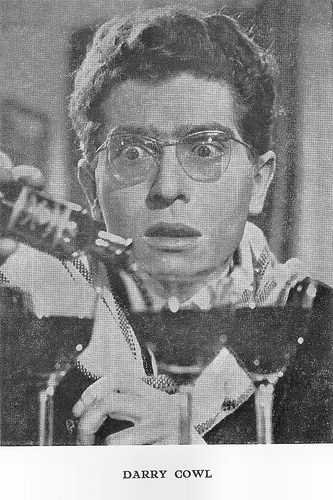
French promotion card by Metropole Le Palais du Cinéma. Publicity still for L'ami de la Famille/A Friend of the Family (Jacques Pinoteau, 1957).
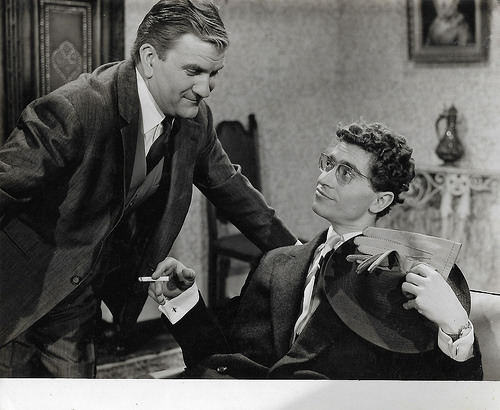
French photo. Publicity still for Vous n'avez rien à déclarer/You have nothing to declare? (Clément Duhour, 1959) with Pierre Mondy.
Scene from Le Triporteur/The Tricycle (1957) with Pierre Mondy. Source: lhierckens111 (YouTube).
Sources: Hal Erickson (AllMovie), Wikipedia, and .

French postcard by Ed. Borde, Bal, no. 106. Photo: Wiezniak / Philips.

French postcard by Editions P.I., Paris, no. 233 (?). Photo: Sam Lévin.

French postcard by Editions du Globe, Paris, no. 743.
Silly ass
Darry Cowl was born as André Darricau in Vittel, France, in 1925. His father was a doctor.
He studied music at the Conservatoire de Paris. After he had finished his studies successfully, he did not chose to work for an orchestra, but became a musical clown in the nightclubs and cabarets of Paris.
He made his film debut in Quatre jours à Paris/Four Days in Paris (André Berthomieu, 1955) with Luis Mariano , and soon appeared in small roles in films like Bonjour sourire/Good Morning Smile (Claude Sautet, 1955), and En effeuillant la marguerite/Mademoiselle Striptease (Marc Allégret, 1956) with Brigitte Bardot .
Director Sacha Guitry cast him twice in Assassins et voleurs/Assassins and Robbers (1957) and in Les Trois font la paire/Three Make a Pair (1957). Cowl decided to focus on film acting.
He gained celebrity status with his role as Antoine Péralou in Le Triporteur/The Tricycle (Jacques Pinoteau, 1957). The stuttering Antoine is a football fanatic, who follows his favourite team from one game to the next madly peddling his tricycle to his various destinations.
Between 1955 and 1965, Cowl played in more than 60 films made by directors like André Berthomieu, Jean Girault and Jacques Pinoteau. He often played the silly ass who stumbles on his lines on purpose.

French postcard by Editions du Globe (E.D.U.G.), Paris, no. 700. Photo: Studio Harcourt.

French postcard by Editions du Globe (E.D.U.G.), Paris, no. 716. Photo: Studio Harcourt.

French postcard by Editions du Globe (E.D.U.G.), Paris, no. 680. Photo: Studio Harcourt.
Game Addict
Darry Cowl was a game addict, and he often acted only for the money in films that did not stretch his acting ability. An exception was Archimède, le clochard/The Magnificent Tramp (Gilles Grangier, 1959) in which he appeared opposite the great Jean Gabin .
In 1964, Cowl directed a feature film himself, Jaloux comme un tigre/Jealous as a Tiger (Darry Cowl, 1964). He also appeared in this comedy, wrote the scenario and composed the score. Sadly it was not a success.
He continued to appear in dozens of comedies, including Les tribulations d'un chinois en Chine/Up to His Ears (Philippe de Broca, 1965) and an episode of Les bons vivants/High Lifers (Gilles Grangier, Georges Lautner, 1965).
In 1974 he played Major Archibald in Touche pas à la femme blanche/Don't Touch the White Woman! (Marco Ferreri, 1974) with Catherine Deneuve , the only film he pretended to be proud about. The next decades most of his films were not very interesting.
He wrote three memoirs, Le flambeur (1986) about his passion for the game, Le triporteur se livre (1994) and Mémoires d'un canaillou (2005).
During the 1990s, he appeared in better films like Ville à vendre/City for Sale (Jean-Pierre Mocky, 1992) starring Michel Serrault , and Les misérables (Claude Lelouch, 1995) starring Jean-Paul Belmondo .
In 1999, he even made a magnificent comeback as the only Caucasian employee of a Chinatown shop in Augustin, roi du Kung-fu/Augustin, King of Kung-Fu (Anne Fontaine, 1999).
Twice he was a awarded a César, the French equivalent of an Oscar. In 2001 he received a César d'honneur for his career, and in 2004 he won another César for for his supporting role as a concierge in Pas sur la bouche/Not on the lips (Alain Resnais, 2004).
He also won a Molière award for Best Supporting Role on the French stage, in 1995. He had hoped to return to theatre acting in Hold Up, a play by Jean Barbier, in September 2005, but ill-health prevented this.
His last film was L'homme qui rêvait d'un enfant/The man Who Dreamed About a Child (Delphine Gleize, 2006). He would never see the finished film.
In 2006, Darry Cowl died in Neuilly-sur-Seine from complications of lung cancer, aged 80. He was married twice, first to Nelly Marco, and the second time to actress Rolande Kalis.

French promotion card by Metropole Le Palais du Cinéma. Publicity still for L'ami de la Famille/A Friend of the Family (Jacques Pinoteau, 1957).

French photo. Publicity still for Vous n'avez rien à déclarer/You have nothing to declare? (Clément Duhour, 1959) with Pierre Mondy.
Scene from Le Triporteur/The Tricycle (1957) with Pierre Mondy. Source: lhierckens111 (YouTube).
Sources: Hal Erickson (AllMovie), Wikipedia, and .
Published on September 04, 2018 22:00
September 3, 2018
Walter Byron
English film actor Walter Byron (1899-1972) appeared in 66 films between 1926 and 1942. Most notably he starred opposite Gloria Swanson in the legendary 'lost' film Queen Kelly (Erich von Stroheim, 1929). Though handsome, he was rather uncharismatic and never quite made the grade as a star.
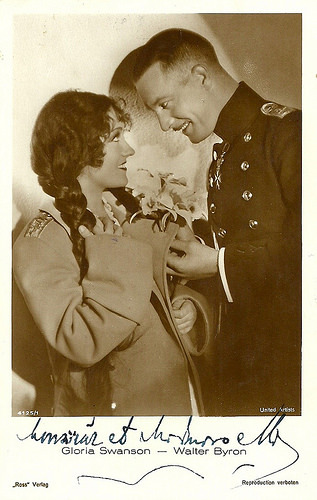
German postcard by Ross Verlag, no. 4125/1, 1929-1930. Photo: United Artists. Publicity still for Queen Kelly (Erich von Stroheim, 1929) with Gloria Swanson .
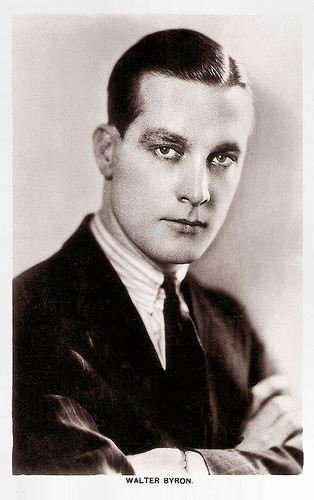
British postcard in the Picturegoer series, London, no. 331.
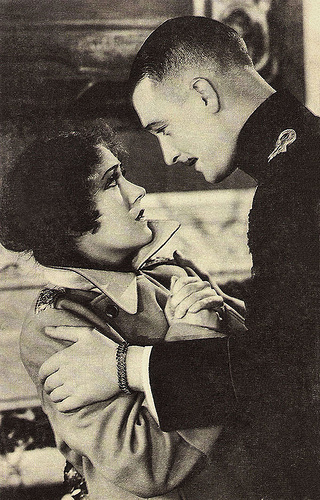
Spanish postcard by Casa Molina, Madrid. Gloria Swanson and Walter Byron in Queen Kelly (Erich von Stroheim, 1929).
Full of innuendo
Walter Byron was born Walter Clarence Butler in 1899 in Leicester, England. He made his film debut as Walter Butler in the lead role of the English short film Dream Faces (Hugh Croise, 1926). In France, he made the comedy Croquette (Louis Mercanton, 1928) opposite Betty Balfour .
Walter's brother, Jack Byron, appeared in Hollywood films from the early 1920s on and Walter joined him in 1928. The handsome young actor got a contract with Samuel Goldwyn. He soon got leading roles in silent films such as the romantic drama The Awakening (Victor Fleming, 1928) opposite Vilma Bánky , now credited as Walter Byron.
His Hollywood career seemed to go uphill when he was cast opposite Mega-star Gloria Swanson in the costume drama Queen Kelly (Erich von Stroheim, 1929). He played Prince Wolfram, the betrothed of mad Queen Regina V of Kronberg (Seena Owen). As punishment for partying with other women, he is sent on manoeuvres. He sees Kitty Kelly (Swanson) walking with other convent students and flirts with her. She is embarrassed when he makes a comment after seeing that her underwear is visible, so she takes it off and throws it at him, to the horror of the nuns, who punish her for her 'indecency'.
Enthralled by her beauty, he kidnaps her that night from the convent, takes her to his room and professes his love for her. When the Queen finds them together the next morning, she whips Kelly and throws her out of the castle. Regina then puts Wolfram in prison for not wanting to marry her.
This part of the film, more than 200,000 feet of footage was directed by Erich von Stroheim when production shooting was halted by Gloria Swanson on 21 January 1929. Only about one-third of the scenario was shot since 1 November 1928 at a cost of $400,000 at the time with a budget of $800,000.
Swanson complained about the direction the film was taking. Though the already filmed European scenes were full of innuendo, and featured a philandering prince and a sex-crazed queen, the coming scenes set in Africa were grim and, Swanson felt, distasteful. Original plot was that Kelly goes to German East Africa to visit her dying aunt and is forced to marry a repulsive man named Jan.
The aunt dies after the wedding and Kelly refuses to live with him, instead becoming the madam of her aunt's brothel. Her extravagances and style earn her the name 'Queen Kelly'. In later interviews, Swanson claimed that she had been misled by the script which referred to her character arriving in, and taking over, a dance hall. When she was looking at the rushes, it was obvious the 'dance hall' was actually a brothel.
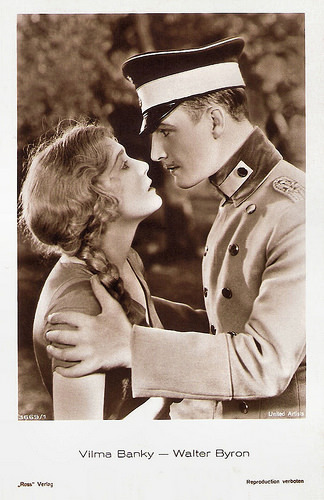
German postcard by Ross Verlag, no. 3669/1, 1928-1929. Photo: United Artists. Publicity still for The Awakening (Victor Fleming, 1928) with Vilma Bánky .
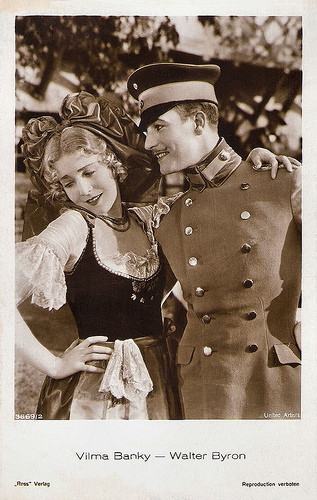
German postcard by Ross Verlag, no. 3669/2, 1928-1929. Photo: United Artists. Publicity still for The Awakening (Victor Fleming, 1928) with Vilma Bánky .
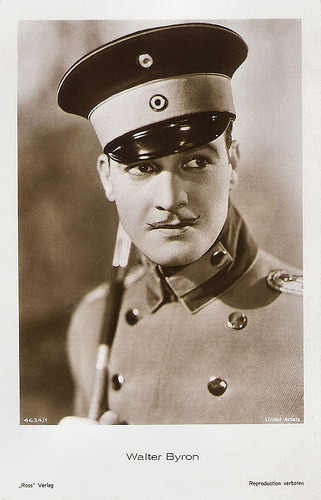
German postcard by Ross Verlag, no. 4634/1, 1929-1930. Photo: United Artists. Publicity still for The Awakening (Victor Fleming, 1928).
Heavy irony
On 9 December 1929, synchronised sound retakes were shot for Queen Kelly. Franz Lehár was hired, at one stage in the rewrite stage, to compose music for the film, but that work was never completed or used. On 24 November 1931, a rewritten ending in which the prince discovers that the desperate Kelly has successfully committed suicide by drowning was after her humiliation at the hands of the Queen was shot by cinematographer Gregg Toland.
This version was released in 1932 in runs that were limited to Europe and South America due to a clause in Erich von Stroheim ’s contract. In 1933, von Stroheim submitted a script called Poto Poto to MGM. Though it was never produced, the script contained several elements recycled from the African story of Queen Kelly.
A short extract of Queen Kelly appears in Sunset Boulevard (Billy Wilder, 1950), representing an old silent picture Swanson's character Norma Desmond - herself a silent movie star - had made. Von Stroheim is also a primary character in Sunset Boulevard, as her ex-director, ex-husband, and current butler. By some accounts, Von Stroheim suggested the clip be used for its heavy irony.
This was the first time viewers in the US got to see any footage of the infamous collaboration. A restoration of the film was produced by Dennis Doros of Kino International in 1985. Kino International restored two versions: one that uses still photos and subtitles in an attempt to wrap up the storyline, and the other the European 'suicide ending' version.
On IMDb , reviewer jrd-73 writes about the restoration: "The Swanson cut is a good movie, with a weak ending. However, it does work as a movie, if a somewhat stunted one. There is a beginning (lovers meet), a middle (lovers spend an enchanted night together), and a quick ending. Along the way, the film conjures some wonderful scenes: Queen Regina with her cat descending upon Prince Wolfram and his dog, Kelly meeting the Prince and losing a piece of clothing, Kelly in the church sanctuary bathed in candlelight, and the climatic meeting between Kelly and the Queen.
By contrast, the restoration is problematic because it fails to go anywhere. There is a beginning, the start of a middle, and then a bunch of scenes, great masterful scenes, but scenes that do not pay off. Then the film ends with an epilogue explaining what the viewer might have seen had the film finished shooting and had then been edited and released the way von Stroheim intended (not a guarantee considering what happened with Greed which was all filmed).
I can appreciate Kino's dilemma. The found, unused scenes from the film feature some of the most astounding visuals and drama of any American silent film. The brothel setting oozes ornamental decadence. Film fans owe a lot to whomever preserved these scenes. Yet, I don't think the restoration works as a self-contained film. The found footage plays like a fascinating twenty minute trailer for a grand epic that no one will ever get to see. By taking out Swanson's ending and putting in this footage, the restorers end with an unfinished film and a frustrating viewing experience."
Walter Byron's career went downhill after Queen Kelly. He was the leading man in lesser Hollywood productions, and could only find supporting or minor roles in A-pictures like Vanity Fair (Chester M. Franklin, 1932) with Myrna Loy, and If You Could Only Cook (1935) with Herbert Marshall and Jean Arthur.
At the end of the 1930s, his parts were often so small he did not get a credit. His final film appearance was as a Ringside Telegrapher in Gentleman Jim (Raoul Walsh, 1942) starring Errol Flynn . In 1972, Walter Byron passed away in Signal Hill, California, USA. He was 72.
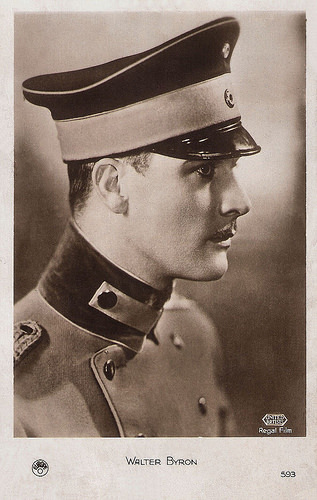
French postcard by Europe, no. 593. Photo: United Artists / Regal Film. Publicity still for The Awakening (Victor Fleming, 1928).
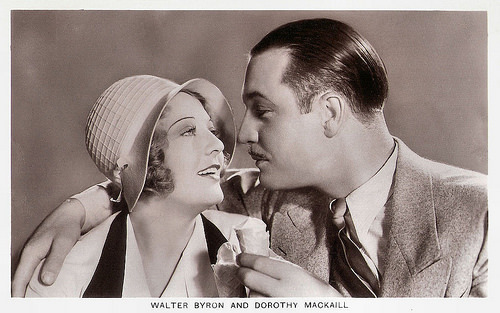
British postcard in the Film Partners series, London, no. P 8. Photo: publicity still for The Reckless Hour (John Francis Dillon, 1931) with Walter Byron and Dorothy MacKaill.
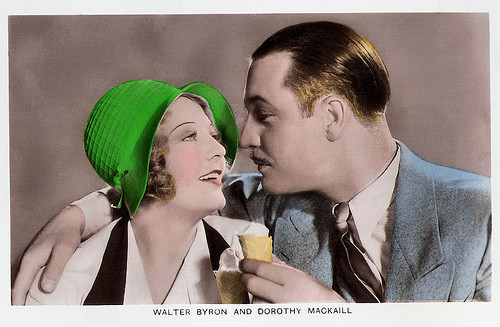
British postcard in the Film Partners series, London, no. PC 8. Photo: publicity still for The Reckless Hour (John Francis Dillon, 1931).
Sources: Silent Era, Wikipedia and .

German postcard by Ross Verlag, no. 4125/1, 1929-1930. Photo: United Artists. Publicity still for Queen Kelly (Erich von Stroheim, 1929) with Gloria Swanson .

British postcard in the Picturegoer series, London, no. 331.

Spanish postcard by Casa Molina, Madrid. Gloria Swanson and Walter Byron in Queen Kelly (Erich von Stroheim, 1929).
Full of innuendo
Walter Byron was born Walter Clarence Butler in 1899 in Leicester, England. He made his film debut as Walter Butler in the lead role of the English short film Dream Faces (Hugh Croise, 1926). In France, he made the comedy Croquette (Louis Mercanton, 1928) opposite Betty Balfour .
Walter's brother, Jack Byron, appeared in Hollywood films from the early 1920s on and Walter joined him in 1928. The handsome young actor got a contract with Samuel Goldwyn. He soon got leading roles in silent films such as the romantic drama The Awakening (Victor Fleming, 1928) opposite Vilma Bánky , now credited as Walter Byron.
His Hollywood career seemed to go uphill when he was cast opposite Mega-star Gloria Swanson in the costume drama Queen Kelly (Erich von Stroheim, 1929). He played Prince Wolfram, the betrothed of mad Queen Regina V of Kronberg (Seena Owen). As punishment for partying with other women, he is sent on manoeuvres. He sees Kitty Kelly (Swanson) walking with other convent students and flirts with her. She is embarrassed when he makes a comment after seeing that her underwear is visible, so she takes it off and throws it at him, to the horror of the nuns, who punish her for her 'indecency'.
Enthralled by her beauty, he kidnaps her that night from the convent, takes her to his room and professes his love for her. When the Queen finds them together the next morning, she whips Kelly and throws her out of the castle. Regina then puts Wolfram in prison for not wanting to marry her.
This part of the film, more than 200,000 feet of footage was directed by Erich von Stroheim when production shooting was halted by Gloria Swanson on 21 January 1929. Only about one-third of the scenario was shot since 1 November 1928 at a cost of $400,000 at the time with a budget of $800,000.
Swanson complained about the direction the film was taking. Though the already filmed European scenes were full of innuendo, and featured a philandering prince and a sex-crazed queen, the coming scenes set in Africa were grim and, Swanson felt, distasteful. Original plot was that Kelly goes to German East Africa to visit her dying aunt and is forced to marry a repulsive man named Jan.
The aunt dies after the wedding and Kelly refuses to live with him, instead becoming the madam of her aunt's brothel. Her extravagances and style earn her the name 'Queen Kelly'. In later interviews, Swanson claimed that she had been misled by the script which referred to her character arriving in, and taking over, a dance hall. When she was looking at the rushes, it was obvious the 'dance hall' was actually a brothel.

German postcard by Ross Verlag, no. 3669/1, 1928-1929. Photo: United Artists. Publicity still for The Awakening (Victor Fleming, 1928) with Vilma Bánky .

German postcard by Ross Verlag, no. 3669/2, 1928-1929. Photo: United Artists. Publicity still for The Awakening (Victor Fleming, 1928) with Vilma Bánky .

German postcard by Ross Verlag, no. 4634/1, 1929-1930. Photo: United Artists. Publicity still for The Awakening (Victor Fleming, 1928).
Heavy irony
On 9 December 1929, synchronised sound retakes were shot for Queen Kelly. Franz Lehár was hired, at one stage in the rewrite stage, to compose music for the film, but that work was never completed or used. On 24 November 1931, a rewritten ending in which the prince discovers that the desperate Kelly has successfully committed suicide by drowning was after her humiliation at the hands of the Queen was shot by cinematographer Gregg Toland.
This version was released in 1932 in runs that were limited to Europe and South America due to a clause in Erich von Stroheim ’s contract. In 1933, von Stroheim submitted a script called Poto Poto to MGM. Though it was never produced, the script contained several elements recycled from the African story of Queen Kelly.
A short extract of Queen Kelly appears in Sunset Boulevard (Billy Wilder, 1950), representing an old silent picture Swanson's character Norma Desmond - herself a silent movie star - had made. Von Stroheim is also a primary character in Sunset Boulevard, as her ex-director, ex-husband, and current butler. By some accounts, Von Stroheim suggested the clip be used for its heavy irony.
This was the first time viewers in the US got to see any footage of the infamous collaboration. A restoration of the film was produced by Dennis Doros of Kino International in 1985. Kino International restored two versions: one that uses still photos and subtitles in an attempt to wrap up the storyline, and the other the European 'suicide ending' version.
On IMDb , reviewer jrd-73 writes about the restoration: "The Swanson cut is a good movie, with a weak ending. However, it does work as a movie, if a somewhat stunted one. There is a beginning (lovers meet), a middle (lovers spend an enchanted night together), and a quick ending. Along the way, the film conjures some wonderful scenes: Queen Regina with her cat descending upon Prince Wolfram and his dog, Kelly meeting the Prince and losing a piece of clothing, Kelly in the church sanctuary bathed in candlelight, and the climatic meeting between Kelly and the Queen.
By contrast, the restoration is problematic because it fails to go anywhere. There is a beginning, the start of a middle, and then a bunch of scenes, great masterful scenes, but scenes that do not pay off. Then the film ends with an epilogue explaining what the viewer might have seen had the film finished shooting and had then been edited and released the way von Stroheim intended (not a guarantee considering what happened with Greed which was all filmed).
I can appreciate Kino's dilemma. The found, unused scenes from the film feature some of the most astounding visuals and drama of any American silent film. The brothel setting oozes ornamental decadence. Film fans owe a lot to whomever preserved these scenes. Yet, I don't think the restoration works as a self-contained film. The found footage plays like a fascinating twenty minute trailer for a grand epic that no one will ever get to see. By taking out Swanson's ending and putting in this footage, the restorers end with an unfinished film and a frustrating viewing experience."
Walter Byron's career went downhill after Queen Kelly. He was the leading man in lesser Hollywood productions, and could only find supporting or minor roles in A-pictures like Vanity Fair (Chester M. Franklin, 1932) with Myrna Loy, and If You Could Only Cook (1935) with Herbert Marshall and Jean Arthur.
At the end of the 1930s, his parts were often so small he did not get a credit. His final film appearance was as a Ringside Telegrapher in Gentleman Jim (Raoul Walsh, 1942) starring Errol Flynn . In 1972, Walter Byron passed away in Signal Hill, California, USA. He was 72.

French postcard by Europe, no. 593. Photo: United Artists / Regal Film. Publicity still for The Awakening (Victor Fleming, 1928).

British postcard in the Film Partners series, London, no. P 8. Photo: publicity still for The Reckless Hour (John Francis Dillon, 1931) with Walter Byron and Dorothy MacKaill.

British postcard in the Film Partners series, London, no. PC 8. Photo: publicity still for The Reckless Hour (John Francis Dillon, 1931).
Sources: Silent Era, Wikipedia and .
Published on September 03, 2018 22:00
September 2, 2018
Mike Bongiorno
Mike Bongiorno (1924-2009) was an Italo-American journalist and television host. For the history of Italian television he has been an institution as Italy’s famous quiz master between the 1950s to the 1980s. Il Re del Quiz (The Quiz King) played himself in various films too.
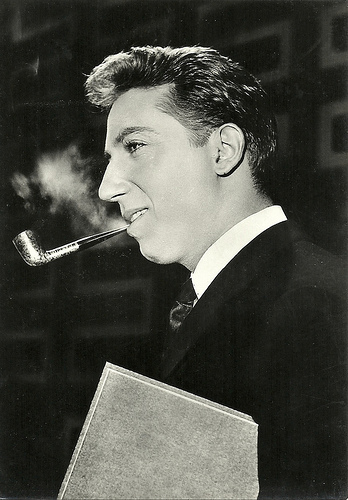
Italian postcard. Photo: publicity still for Totò lascia o raddoppia.
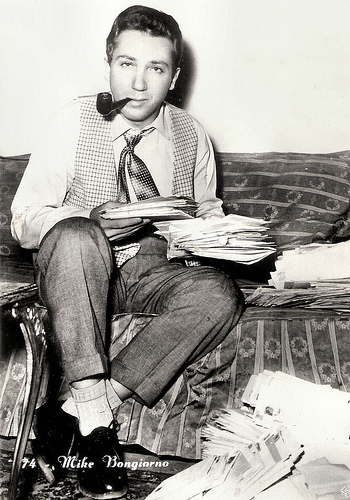
Italian postcard by Turismofoto, no. 74.
Go-Between for the Italian partisans and the Allies
Michael Nicholas Salvatore Bongiorno was born 26 May 1924 in New York. He was of Italo-American descent, his paternal grandfather being a merchant who emigrated from Mezzojuso in Sicily.
While he was a child his parents divorced and his mother took him to her hometown Turin, where he visited college. All his life he remained a fan of Juventus, Turin’s soccer club.
During the Second World War he was not mobilised thanks to his American nationality. He dropped his studies and joined the Italian resistance as a go-between for the Italian partisans and the Allies in Switzerland. He was captured and escaped execution because of his American passport.
For six months he was held at the San Vittore prison of Milan, and was then deported to a German concentration camp. Early 1945 he was liberated even before the war had ended, thanks to an exchange between war prisoners.
He returned to New York and in 1946 he started to work at the radio headquarters of Il progresso italo-americano (The Italian-American progress) newspaper.
Bongiorno established himself in Italy in 1952. There he became the most popular television host form the earliest days of the medium on. He worked for the national public broadcasting company RAI, and started with the programme Arrivi e partenze (1953, Arrivals and Departures).
In the mid-1950s, Bongiorno acted in various films. First in Luigi Zampa’s comedy Ragazze d'oggi/Girls of Today (1955), starring Marisa Allasio .
In the same year Bongiorno re-enacted himself in the comedy Il motive in maschera/Reason masked (Stefano Canzio, 1955), based on Bongiorno’s popular homonymous radio show in which the contestants had to recognise a popular tune disguised as a classical one.
Next followed a lead in Guido Malatesta’s comedy I milliardari/The billionaires (1956), and a part in the film Il prezzo della gloria/The price of glory (Antonio Musu, 1956), starring Gabriele Ferzetti , and shot in the province of Puglia, in South-East Italy. Bongiorno acted in a scene shot at Taranto, where his character has car trouble.
In the 1950s Bongiorno also appeared in several Fotoromanzi, the typical Italian photo novel in which the characters are often portrayed by well-known actors.

Italian postcard. Photo: publicity still for Ragazze d'oggi (1955) with Marisa Allasio .
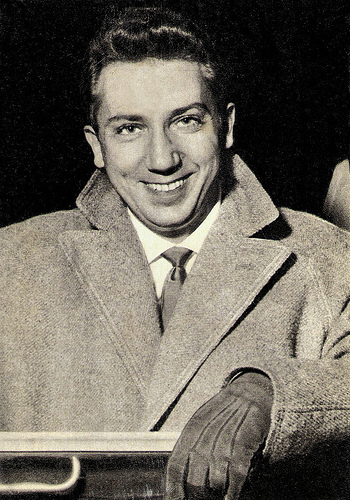
Italian postcard by Editions R.D.V., Milano, no. 163.
Italy’s quiz master ‘par excellence’
From 1955 to 1959 Mike Bongiorno ran the first Italian television quiz Lascia o raddoppia?, based on the French Quitte ou double?, which again was based on the American quiz The $64,000 Question.
Buongorno became Italy’s quiz master ‘par excellence’. Italian writer and semiologist Umberto Eco even dedicated a famous essay to him: Fenomenologia di Mike Bongiorno/Phenomenology of Mike Bongiorno (1963).
This also affected Bongiorno’s film acting, who from the 1950s on was seen as a quiz master, like in Totò lascia o raddoppia?/Totò, double or nothing? (Camillo Mastrocinque, 1958) with Totò , and Giudizio universale (Vittorio De Sica, 1961) with Vittorio Gassman , Fernandel and Alberto Sordi.
In the classic C'eravamo tanto amati/We All Loved Each Other So Much (Ettore Scola, 1978) one of the three idealistic friends, played by Stefano Satta Flores, is a candidate in Bongiorno's quiz Lascia o raddoppia.
His other films include the comic Western La vita, a volte, è molto dura, vero Provvidenza?/Sometimes Life Is Hard - Right, Providence? (Giulio Petroni, 1972) with Tomas Milian , and the Sci-Fi comedy Sogni mostruosamente proibiti/Dream Monster dreams (Neri Parenti, 1982) with Alida Valli .
After Lascia o raddoppia followed the quizzes Campanile sera (1959-1962, Bell Tower Evening), La fiera dei sogni (1962–1965, Dream Fair) and Rischiatutto (1970-1974, Jeopardy!). With 20 to 30 million watchers every Thursday night, Rischiatutto had the highest audience in the history of Italian TV. From 1963 on Bongiorno also presented the Festival of San Remo for over a decade.
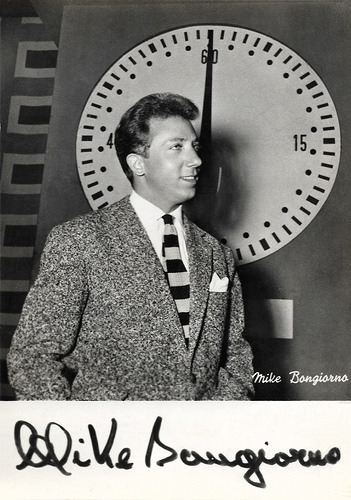
Italian promotion card by Brunner & Co, Como, 1956, offered by Oreal. Photo: Giole. Mike Bongiorno was at the time the host of the radio show Il motivo senza Maschera (1956).

Italian autograph card by Afga-Gevaert.
Allergia!
In 1979, Mike Bongiorno presented his first show for commercial television: I sogni nel cassetto (The dreams in the drawer), produced by Telemilano, which later became Canale 5. His last RAI quiz show was Flash (1980-1982), after which he completely moved over to Mediaset, the television group of Silvio Berlusconi.
Afterwards, Telequiz Bis (1981) Superflash (1982), Pentathlon (1985), Telemike (1987) and La ruota della fortuna (1989, Wheel of Fortune) followed. In 2000 he co-presented the animal programme Qua la zampa. For the Retequattro channel, he presented two quizzes for youngsters: Genius and Il migliore (The Best).
Mike Bongiorno was rewarded with a doctorate honoris causa at the university IULM of Milan in August 2007. For decades, Bongiorno, who always opened his programmes with his famous "Allegria!" (Cheers!), was known everywhere. Also known were his problems with finding the right quiz papers, his endearing old-fashioned Italian, but also his rages against technicians and candidates during his shows, even in live recordings.
His mistakes were proverbial, in particular during La ruota della fortuna. During one quiz he asked who was this Mr. Paolovi? Meant was Paolo VI (pope Paul VI). Imitation and parody resulted in maliciously changing his "Allegria!" in "Allergia!" (allergy). Bongiorno was nicknamed 'SuperMike' and 'Telemike'. Even if he lived in Italy for most of his life, he kept his American nationality until he turned 79.
Mike Bongiorno died of a heart attack in 2009 in Monte Carlo, Monaco. He was married was three times and with Daniela Zuccoli, he had 3 children. Their son Michele Bongiorno (1973) is a television producer, and their second son Nicolò Bongiorno (1976) is a director of documentaries.
A fan's tribute to Mike Bongiorno. Source: Enzo Livero (YouTube).
Sources: Wikipedia (English, Italian and French), and .

Italian postcard. Photo: publicity still for Totò lascia o raddoppia.

Italian postcard by Turismofoto, no. 74.
Go-Between for the Italian partisans and the Allies
Michael Nicholas Salvatore Bongiorno was born 26 May 1924 in New York. He was of Italo-American descent, his paternal grandfather being a merchant who emigrated from Mezzojuso in Sicily.
While he was a child his parents divorced and his mother took him to her hometown Turin, where he visited college. All his life he remained a fan of Juventus, Turin’s soccer club.
During the Second World War he was not mobilised thanks to his American nationality. He dropped his studies and joined the Italian resistance as a go-between for the Italian partisans and the Allies in Switzerland. He was captured and escaped execution because of his American passport.
For six months he was held at the San Vittore prison of Milan, and was then deported to a German concentration camp. Early 1945 he was liberated even before the war had ended, thanks to an exchange between war prisoners.
He returned to New York and in 1946 he started to work at the radio headquarters of Il progresso italo-americano (The Italian-American progress) newspaper.
Bongiorno established himself in Italy in 1952. There he became the most popular television host form the earliest days of the medium on. He worked for the national public broadcasting company RAI, and started with the programme Arrivi e partenze (1953, Arrivals and Departures).
In the mid-1950s, Bongiorno acted in various films. First in Luigi Zampa’s comedy Ragazze d'oggi/Girls of Today (1955), starring Marisa Allasio .
In the same year Bongiorno re-enacted himself in the comedy Il motive in maschera/Reason masked (Stefano Canzio, 1955), based on Bongiorno’s popular homonymous radio show in which the contestants had to recognise a popular tune disguised as a classical one.
Next followed a lead in Guido Malatesta’s comedy I milliardari/The billionaires (1956), and a part in the film Il prezzo della gloria/The price of glory (Antonio Musu, 1956), starring Gabriele Ferzetti , and shot in the province of Puglia, in South-East Italy. Bongiorno acted in a scene shot at Taranto, where his character has car trouble.
In the 1950s Bongiorno also appeared in several Fotoromanzi, the typical Italian photo novel in which the characters are often portrayed by well-known actors.

Italian postcard. Photo: publicity still for Ragazze d'oggi (1955) with Marisa Allasio .

Italian postcard by Editions R.D.V., Milano, no. 163.
Italy’s quiz master ‘par excellence’
From 1955 to 1959 Mike Bongiorno ran the first Italian television quiz Lascia o raddoppia?, based on the French Quitte ou double?, which again was based on the American quiz The $64,000 Question.
Buongorno became Italy’s quiz master ‘par excellence’. Italian writer and semiologist Umberto Eco even dedicated a famous essay to him: Fenomenologia di Mike Bongiorno/Phenomenology of Mike Bongiorno (1963).
This also affected Bongiorno’s film acting, who from the 1950s on was seen as a quiz master, like in Totò lascia o raddoppia?/Totò, double or nothing? (Camillo Mastrocinque, 1958) with Totò , and Giudizio universale (Vittorio De Sica, 1961) with Vittorio Gassman , Fernandel and Alberto Sordi.
In the classic C'eravamo tanto amati/We All Loved Each Other So Much (Ettore Scola, 1978) one of the three idealistic friends, played by Stefano Satta Flores, is a candidate in Bongiorno's quiz Lascia o raddoppia.
His other films include the comic Western La vita, a volte, è molto dura, vero Provvidenza?/Sometimes Life Is Hard - Right, Providence? (Giulio Petroni, 1972) with Tomas Milian , and the Sci-Fi comedy Sogni mostruosamente proibiti/Dream Monster dreams (Neri Parenti, 1982) with Alida Valli .
After Lascia o raddoppia followed the quizzes Campanile sera (1959-1962, Bell Tower Evening), La fiera dei sogni (1962–1965, Dream Fair) and Rischiatutto (1970-1974, Jeopardy!). With 20 to 30 million watchers every Thursday night, Rischiatutto had the highest audience in the history of Italian TV. From 1963 on Bongiorno also presented the Festival of San Remo for over a decade.

Italian promotion card by Brunner & Co, Como, 1956, offered by Oreal. Photo: Giole. Mike Bongiorno was at the time the host of the radio show Il motivo senza Maschera (1956).

Italian autograph card by Afga-Gevaert.
Allergia!
In 1979, Mike Bongiorno presented his first show for commercial television: I sogni nel cassetto (The dreams in the drawer), produced by Telemilano, which later became Canale 5. His last RAI quiz show was Flash (1980-1982), after which he completely moved over to Mediaset, the television group of Silvio Berlusconi.
Afterwards, Telequiz Bis (1981) Superflash (1982), Pentathlon (1985), Telemike (1987) and La ruota della fortuna (1989, Wheel of Fortune) followed. In 2000 he co-presented the animal programme Qua la zampa. For the Retequattro channel, he presented two quizzes for youngsters: Genius and Il migliore (The Best).
Mike Bongiorno was rewarded with a doctorate honoris causa at the university IULM of Milan in August 2007. For decades, Bongiorno, who always opened his programmes with his famous "Allegria!" (Cheers!), was known everywhere. Also known were his problems with finding the right quiz papers, his endearing old-fashioned Italian, but also his rages against technicians and candidates during his shows, even in live recordings.
His mistakes were proverbial, in particular during La ruota della fortuna. During one quiz he asked who was this Mr. Paolovi? Meant was Paolo VI (pope Paul VI). Imitation and parody resulted in maliciously changing his "Allegria!" in "Allergia!" (allergy). Bongiorno was nicknamed 'SuperMike' and 'Telemike'. Even if he lived in Italy for most of his life, he kept his American nationality until he turned 79.
Mike Bongiorno died of a heart attack in 2009 in Monte Carlo, Monaco. He was married was three times and with Daniela Zuccoli, he had 3 children. Their son Michele Bongiorno (1973) is a television producer, and their second son Nicolò Bongiorno (1976) is a director of documentaries.
A fan's tribute to Mike Bongiorno. Source: Enzo Livero (YouTube).
Sources: Wikipedia (English, Italian and French), and .
Published on September 02, 2018 22:00
September 1, 2018
Paola Borboni
Paola Borboni (1900-1995) was one of the greatest Italian stage actresses of the 20th Century. From 1918 on, she played in over 80 films. She was also often heard on the radio and seen on television, but her true passion was the stage.

Italian postcard, no. 602/3. Photo: Massaglia, Torino.
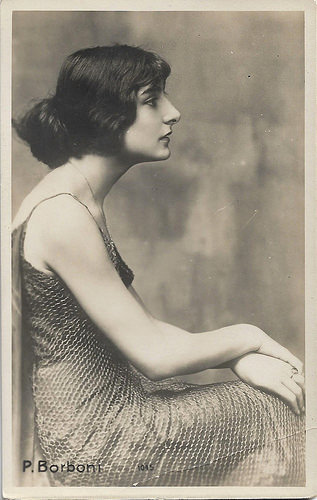
Italian postcard by Ed. Vettori, Bologna, no. 1045.
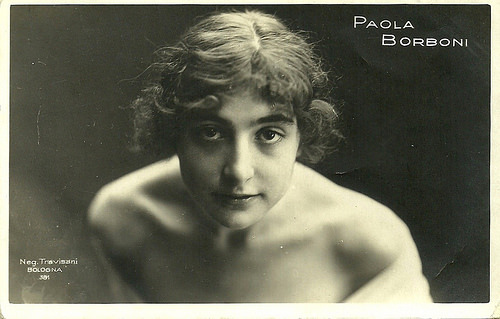
Italian postcard by Ed. Vettori, Bologna, no. 381 Photo: Trevisani, Bologna.
Ever Seen A Mermaid Wearing A Coat?
Paola Borboni was born near Parma on New Year's Day 1900, as daughter of a lyrical impresario.
Paola started to act on stage at age 16. Two years later, she was already 'prima attrice' next to Romano Calò and later to Irma Gramatica .
She excelled in particular in the lighter genre, helped by her beauty and her uninhibited behaviour. When playing a mermaid in 1925, she showed her breasts, creating a scandal, but reacting: 'Ever seen a mermaid wearing a coat?'
With the years her roles became more mature and complex. In the 1930s and 1940s, she played for two seasons with Ruggero Ruggeri and in 1934 she also founded her own company. She'd play anything, from Gabriele D'Annunzio to George Bernard Shaw, but Luigi Pirandello was her favourite.
From 1918 on, Paola Borboni also played in films, starting with the silent film Jacopo Ortis/Jacob Ortis (Giuseppe Sterni, 1918), a Milano Film production based on a novel by Ugo Foscolo.
Until 1921, Borboni played in 6 more silent films, directed by Giuseppe Sterni, Giuseppe Guarino and Eugenio Perego.
After that, she exclusively focused on the stage, until the mid-1930s, when she returned with the female lead in Gennaro Righelli's sound film Lo smemorato/The Forgetful (1936), costarring Angelo Musco.
Between 1936 and 1956 her career was at its peak. She had a steady and continuous output of film performances, mainly in supporting roles as in the Tito Schipa vehicle Vivere/To Live (Guido Brignone, 1937).
She played leading parts as in the romantic comedy Ho perduto mio marito/I Have Lost My Husband (Enrico Guazzoni, 1937) with Nino Besozzi, Ricchezza senza domani/Wealth without a future (Ferdinando Maria Poggioli, 1940), and Il viaggio del signor Perrichon/The journey of Mr. Perrichon (Paolo Moffa, 1943). Mostly, however, Borboni played supporting parts in the cinema.
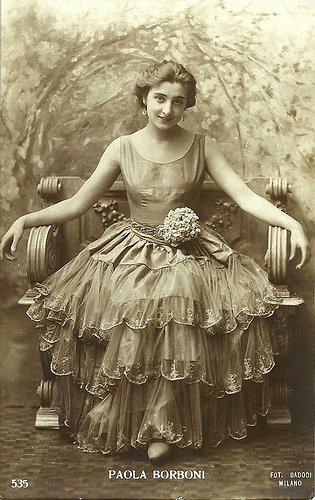
Italian postcard by Ed. A. Traldi, Milano, no. 535. Photo: Badodi, Milano.

Italian postcard, no. 602/1. Photo: Massaglia, Torino.
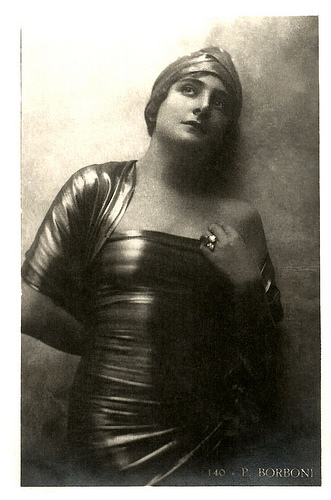
Italian postcard, no. 140.
A Husband 40 Years Younger Than She Was
In the postwar era, Paola Borboni played twice on stage under direction of Luchino Visconti: in Vittorio Alfieri's Oreste (1949), and in Arthur Miller's Il Crogiuolo (The Crucible) (1955).
In the 1950s and 1960s, she became famous for her monologues on stage. In these years she was also well-known for her open air theatre performances all over the country.
In the cinema she had substantial or minor parts in several classic titles of the Italian film history. She played the school principal in the comedy Il biricchino di papà/The mischievous Dad (Raffaele Matarazzo, 1943) featuring Armando Falconi , the Russian princess in Sorelle Materassi/The Sisters Materassi (Ferdinando Maria Poggioli, 1944) featuring Emma and Irma Gramatica, the actress Dejanira in La locandiera/The landlady (Luigi Chiarini, 1944), Matilde in Roma ore 11/Rome at 11 (Giuseppe De Santis, 1952), and the aunt baroness in Pietro Germi's Gelosia/Jealousy (1953).
Borboni was a charwoman in William Wyler's Roman Holiday (1953) starring Audrey Hepburn . Other roles were signora Rubini in I vitelloni (Federico Fellini, 1953), the mother of Bruno Sacchi in Terza liceo/High School (Luciano Emmer, 1954), and signora Monti in Casta diva (Carmine Gallone, 1956) starring Antonella Lualdi .
During the 1960s and 1970s, her films included L'oro di Roma/Gold of Rome (Carlo Lizzani, 1961), Arabella (Mauro Bolognini, 1967), and Per grazia ricevuta/Between Miracles (1971), directed by and starring Nino Manfredi .
From 1942 to 1946 Paola Borboni had a relationshop with the Sicilian actor Salvo Randone. In 1972 the 72-years old Borboni married poet and actor Bruno Vilar, who was 40 years younger than she was. In 1978 they had a terrible car accident, which killed Vilar and crippled Borboni.
Borboni, though, continued to play in films. Her later roles included Mrs. Baldi in La cage aux folles II (Edouard Molinaro, 1980), sister Theresa in Yes, Giorgio (Franklin Shaffner, 1982), and the marchioness of Querceto in the Johnny Dorelli comedy Occhio, malocchio, prezzemolo e finocchio/Eye, evil eye, parsley and fennel (Sergio Martino, 1983).
Her final film appearance was in Blue dolphin - l'avventura continua/Blue Dolphin - The Adventure Continues (Giorgio Mosa, 1990).
While staying in a home in Varese, Paola Borboni died in 1995 because of a stroke and was buried in the family tomb in Parma. She was 95. All in all, she had played in 86 films in nine decades of cinema.

Italian postcard by G. Ballerini & Co., Firenze, no. 602/4. Photo: Massaglia, Torino.
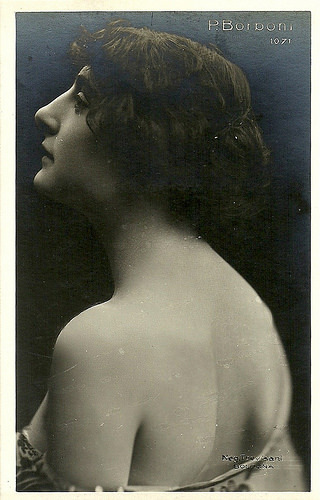
Italian postcard by Ed. Vettori, Bologna, no. 1071. Photo: Trevisani, Bologna.
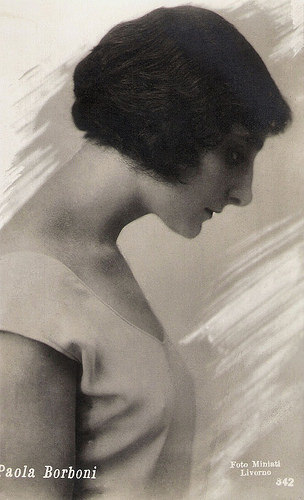
Italian postcard by Casa Editrice Ballerini & Fratini, Firenze, no. 342. Photo: Miniati, Livorno.
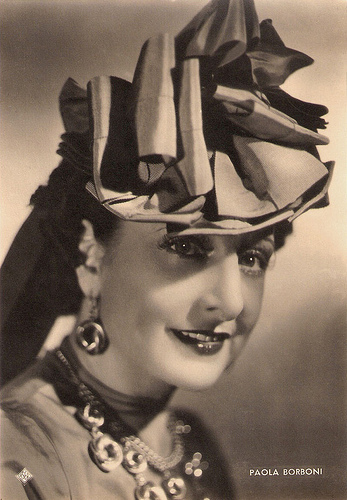
Italian postcard by ASER (A. Scaramaglia Ed. Roma), no. 205, early 1940s. Photo: Vaselli / Lux Film.
Sources: Wikipedia (English and Italian), and

Italian postcard, no. 602/3. Photo: Massaglia, Torino.

Italian postcard by Ed. Vettori, Bologna, no. 1045.

Italian postcard by Ed. Vettori, Bologna, no. 381 Photo: Trevisani, Bologna.
Ever Seen A Mermaid Wearing A Coat?
Paola Borboni was born near Parma on New Year's Day 1900, as daughter of a lyrical impresario.
Paola started to act on stage at age 16. Two years later, she was already 'prima attrice' next to Romano Calò and later to Irma Gramatica .
She excelled in particular in the lighter genre, helped by her beauty and her uninhibited behaviour. When playing a mermaid in 1925, she showed her breasts, creating a scandal, but reacting: 'Ever seen a mermaid wearing a coat?'
With the years her roles became more mature and complex. In the 1930s and 1940s, she played for two seasons with Ruggero Ruggeri and in 1934 she also founded her own company. She'd play anything, from Gabriele D'Annunzio to George Bernard Shaw, but Luigi Pirandello was her favourite.
From 1918 on, Paola Borboni also played in films, starting with the silent film Jacopo Ortis/Jacob Ortis (Giuseppe Sterni, 1918), a Milano Film production based on a novel by Ugo Foscolo.
Until 1921, Borboni played in 6 more silent films, directed by Giuseppe Sterni, Giuseppe Guarino and Eugenio Perego.
After that, she exclusively focused on the stage, until the mid-1930s, when she returned with the female lead in Gennaro Righelli's sound film Lo smemorato/The Forgetful (1936), costarring Angelo Musco.
Between 1936 and 1956 her career was at its peak. She had a steady and continuous output of film performances, mainly in supporting roles as in the Tito Schipa vehicle Vivere/To Live (Guido Brignone, 1937).
She played leading parts as in the romantic comedy Ho perduto mio marito/I Have Lost My Husband (Enrico Guazzoni, 1937) with Nino Besozzi, Ricchezza senza domani/Wealth without a future (Ferdinando Maria Poggioli, 1940), and Il viaggio del signor Perrichon/The journey of Mr. Perrichon (Paolo Moffa, 1943). Mostly, however, Borboni played supporting parts in the cinema.

Italian postcard by Ed. A. Traldi, Milano, no. 535. Photo: Badodi, Milano.

Italian postcard, no. 602/1. Photo: Massaglia, Torino.

Italian postcard, no. 140.
A Husband 40 Years Younger Than She Was
In the postwar era, Paola Borboni played twice on stage under direction of Luchino Visconti: in Vittorio Alfieri's Oreste (1949), and in Arthur Miller's Il Crogiuolo (The Crucible) (1955).
In the 1950s and 1960s, she became famous for her monologues on stage. In these years she was also well-known for her open air theatre performances all over the country.
In the cinema she had substantial or minor parts in several classic titles of the Italian film history. She played the school principal in the comedy Il biricchino di papà/The mischievous Dad (Raffaele Matarazzo, 1943) featuring Armando Falconi , the Russian princess in Sorelle Materassi/The Sisters Materassi (Ferdinando Maria Poggioli, 1944) featuring Emma and Irma Gramatica, the actress Dejanira in La locandiera/The landlady (Luigi Chiarini, 1944), Matilde in Roma ore 11/Rome at 11 (Giuseppe De Santis, 1952), and the aunt baroness in Pietro Germi's Gelosia/Jealousy (1953).
Borboni was a charwoman in William Wyler's Roman Holiday (1953) starring Audrey Hepburn . Other roles were signora Rubini in I vitelloni (Federico Fellini, 1953), the mother of Bruno Sacchi in Terza liceo/High School (Luciano Emmer, 1954), and signora Monti in Casta diva (Carmine Gallone, 1956) starring Antonella Lualdi .
During the 1960s and 1970s, her films included L'oro di Roma/Gold of Rome (Carlo Lizzani, 1961), Arabella (Mauro Bolognini, 1967), and Per grazia ricevuta/Between Miracles (1971), directed by and starring Nino Manfredi .
From 1942 to 1946 Paola Borboni had a relationshop with the Sicilian actor Salvo Randone. In 1972 the 72-years old Borboni married poet and actor Bruno Vilar, who was 40 years younger than she was. In 1978 they had a terrible car accident, which killed Vilar and crippled Borboni.
Borboni, though, continued to play in films. Her later roles included Mrs. Baldi in La cage aux folles II (Edouard Molinaro, 1980), sister Theresa in Yes, Giorgio (Franklin Shaffner, 1982), and the marchioness of Querceto in the Johnny Dorelli comedy Occhio, malocchio, prezzemolo e finocchio/Eye, evil eye, parsley and fennel (Sergio Martino, 1983).
Her final film appearance was in Blue dolphin - l'avventura continua/Blue Dolphin - The Adventure Continues (Giorgio Mosa, 1990).
While staying in a home in Varese, Paola Borboni died in 1995 because of a stroke and was buried in the family tomb in Parma. She was 95. All in all, she had played in 86 films in nine decades of cinema.

Italian postcard by G. Ballerini & Co., Firenze, no. 602/4. Photo: Massaglia, Torino.

Italian postcard by Ed. Vettori, Bologna, no. 1071. Photo: Trevisani, Bologna.

Italian postcard by Casa Editrice Ballerini & Fratini, Firenze, no. 342. Photo: Miniati, Livorno.

Italian postcard by ASER (A. Scaramaglia Ed. Roma), no. 205, early 1940s. Photo: Vaselli / Lux Film.
Sources: Wikipedia (English and Italian), and
Published on September 01, 2018 22:00
August 31, 2018
Photo by Studio Arnal
Today EFSP presents some old film star postcards which will allow you to have a glimpse of the work of the French photo studio Arnal. The small studio was located at the time in Paris at the Boulevard de Rochechouart, the street situated at the foot of Montmartre. In the 1930s, Arnal was specialised in glamorous portraits of stars of the stage and the screen. They were produced on many postcard of publishers like Editions Chantal and Cinémagazine-Édition. The Lithuanian exile photographer Izis (Izraëlis Biderman), to whom the city of Paris paid tribute in 2010 with the exbibition ‘Izis, Paris des rêves’, worked at studio Arnal in 1933-1934.
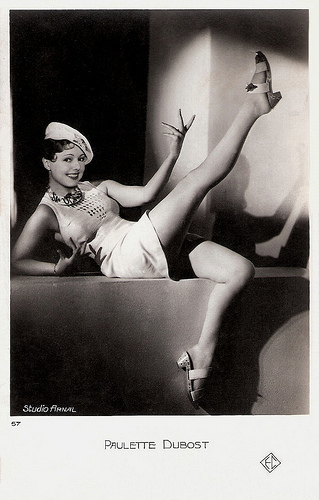
Paulette Dubost . French postcard by EC, no. 57. Photo: Studio Arnal.
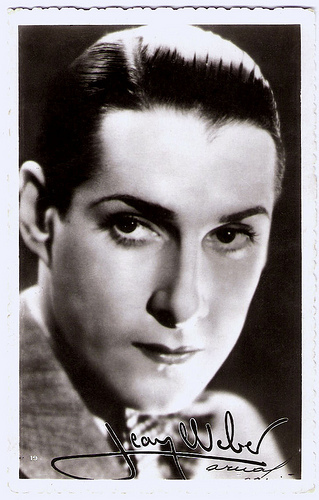
Jean Weber . French postcard by Editions et Publications Cinematographiques, no. 19. Photo: Arnal.
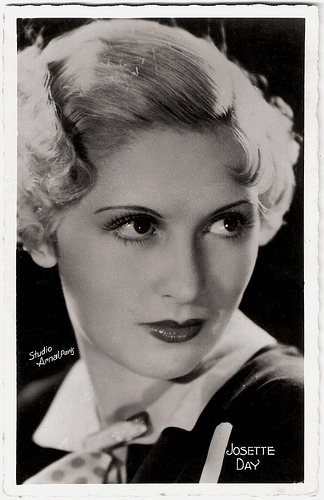
Josette Day . French postcard by Editions et Publications Cinematographiques. Photo: Studio Arnal, Paris.
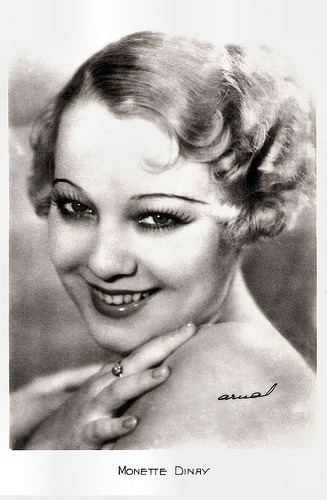
Monette Dinay. French postcard. Photo: Arnal.
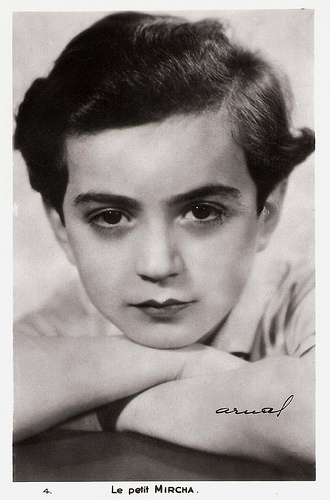
Mircha. French postcard, no. 4. Photo: Arnal.
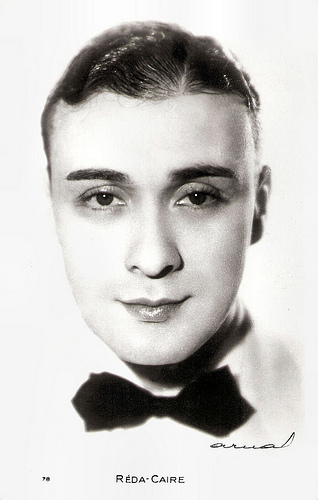
Reda Caire . French postcard, no. 78. Photo: Arnal.
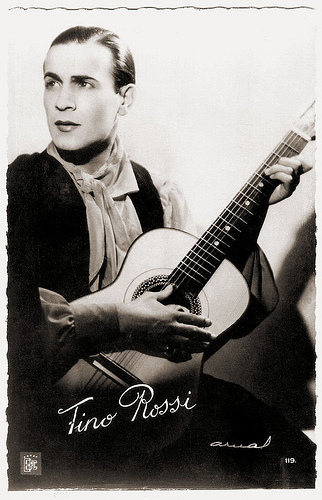
Tino Rossi . French postcard by Editions et Publications Cinématographiques, no. 119. Photo: Arnal.
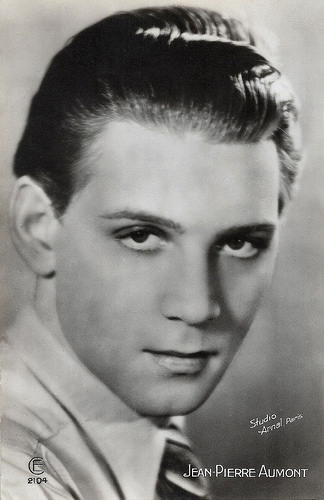
Jean-Pierre Aumont . French postcard by Cinémagazine-Édition (CE), Paris, no. 2104. Photo: Studio Arnal, Paris.
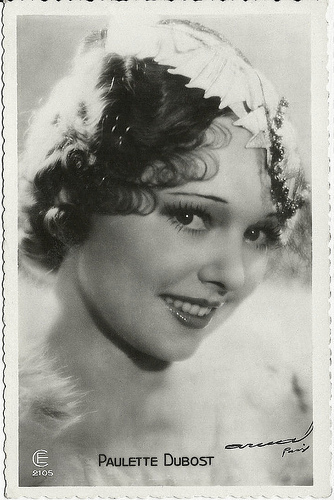
Paulette Dubost . French postcard by Cinémagazine-Édition (CE), Paris, no. 2105. Photo: Studio Arnal.
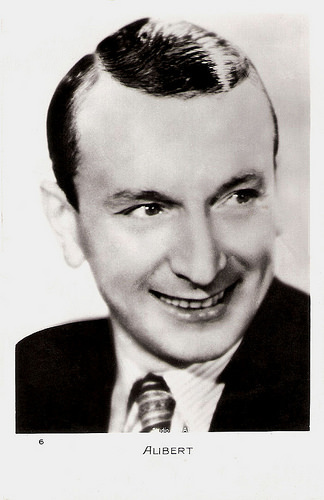
Henri Alibert . French postcard by Editions Chantal, Paris, no. 6. Photo: Studio Arnal.
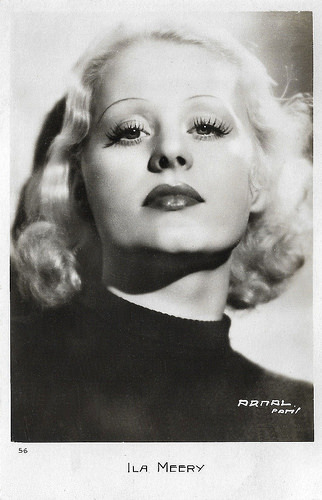
Ila Meery. French postcard by Editions Chantal, no. 56. Photo: Arnal, Paris.
Source: Marlene Pilaete (La Collectionneuse - French).

Paulette Dubost . French postcard by EC, no. 57. Photo: Studio Arnal.

Jean Weber . French postcard by Editions et Publications Cinematographiques, no. 19. Photo: Arnal.

Josette Day . French postcard by Editions et Publications Cinematographiques. Photo: Studio Arnal, Paris.

Monette Dinay. French postcard. Photo: Arnal.

Mircha. French postcard, no. 4. Photo: Arnal.

Reda Caire . French postcard, no. 78. Photo: Arnal.

Tino Rossi . French postcard by Editions et Publications Cinématographiques, no. 119. Photo: Arnal.

Jean-Pierre Aumont . French postcard by Cinémagazine-Édition (CE), Paris, no. 2104. Photo: Studio Arnal, Paris.

Paulette Dubost . French postcard by Cinémagazine-Édition (CE), Paris, no. 2105. Photo: Studio Arnal.

Henri Alibert . French postcard by Editions Chantal, Paris, no. 6. Photo: Studio Arnal.

Ila Meery. French postcard by Editions Chantal, no. 56. Photo: Arnal, Paris.
Source: Marlene Pilaete (La Collectionneuse - French).
Published on August 31, 2018 22:00
August 30, 2018
Teri Tordai
Hungarian actress Teri Tordai (1941) appeared in interesting films by such noted directors as Karoly Makk, István Szabó, Márta Mészáros and Péter Bacsó. During the late 1960s and 1970s she showed her strikingly beautiful looks in several mediocre German and Austrian comedies and sexploitation films.
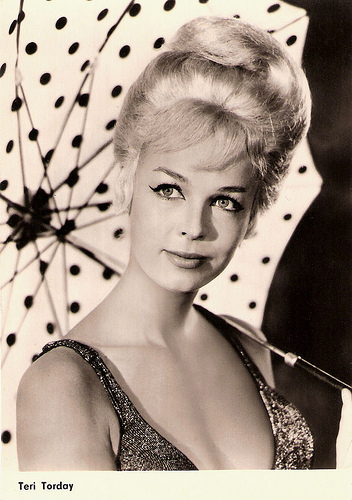
East-German postcard by VEB Progress Filmvertrieb, Berlin, no. 2613, 1966. Retail price: 0,20 MDN.
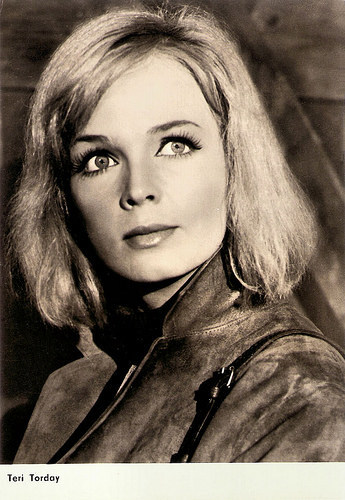
East-German postcard by VEB Progress Filmvertrieb, Berlin, no. 2694, 1966. Retail price: 0,20 MDN.
Sexy Susan
Teri Tordai (also Teri Torday and Terry Torday) was born in Debrecen, Hungary, in 1941.
She received early ballet training and from 1960 on she took acting lessons at the television and film school in Budapest. After graduating in 1964 she played at the National Theatre and the Comedy Theatre.
Already in 1962, she made her first film appearance in the Hungarian film Esös vasárnap/Rainy Sunday (Márton Keleti, 1962). She played one of the leads opposite Gyöngyi Polónyi and Ilona Béres.
In the next years, parts followed in such Hungarian productions as Utolsó elötti ember/The Last But One (Karoly Makk, 1963) and the comedy Mit csinált Felséged 3-tól 5-ig?/What did Sire do between 15 and 17 hour? (Károly Makk, 1964) with Éva Pap and Ildiko Pecso.
She starred opposite Mari Töröcsik in Tilos a szerelem/Forbidden love (Tamás Rényi, 1965).
In 1965 she also made her first German film, the comedy Ferien mit Piroschka/Holiday with Piroschka (Franz Josef Gottlieb, 1965) starring Marie Versini and Götz George . Paradoxically she played a German in Hungary.
Under the name Terry Torday she played title character Susanne in the sexy comedy Susanne, die Wirtin von der Lahn/The Sweet Sins of Sexy Susan (Franz Antel, 1967). The success of this sexy comedy led to a series of six films about the Wirtin von der Lahn (Hostess of the Lahn) all under the direction of Franz Antel.
But she also continued to appear in Hungarian films, including the historical drama Egy magyar nabob/The Hungarian nabob (Zoltán Várkonyi, 1966), and A gyáva/The Coward (Imre Mihályfi, 1971).
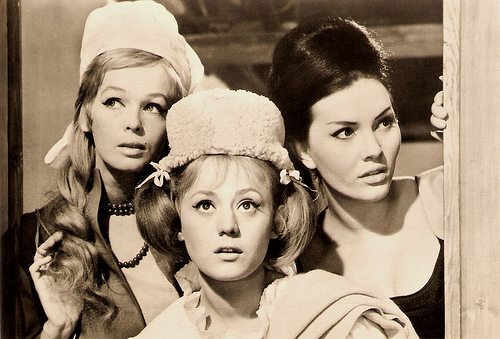
East-German postcard by VEB Progress Filmvertrieb, Berlin, no. 2368, 1965. Retail price: 0,20 MDN. Photo: publicity still for Mit csinált Felséged 3-tól 5-ig?/What did Sire do between 15 and 17 hour? (Károly Makk, 1964).
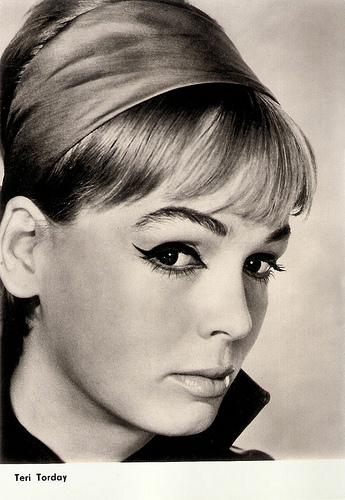
East-German postcard by VEB Progress Filmvertrieb, Berlin, no. 2.555, 1966. Photo: Hungarofilm. Publicity still for Mit csinált Felséged 3-tól 5-ig?/Where Was Your Majesty Between 3 and 5 (Károly Makk, 1964).
Dangerous Temptress
From the 1970s on, Teri Tordai regularly appeared on Hungarian television. Among the TV-films in which she appeared were the romance A vasrács/The iron bars (Tamás Rényi, 1971), Jó estét nyár, jó estét szerelem/A good summer evening, good evening, love (Sándor Szönyi G., 1972) and the Pan-European adventure series Les évasions célèbres/The famous escapes (Christian Jacque a.o., 1972).
An interesting Hungarian film in which she appeared during this period was the adventure film A Pendragon legenda/The Pendragon Legend (György Révész, 1974) with Iván Darvas.
At the time, she appeared in a total of 18 productions for the Austrian film studio Neue Delta. She often played a dangerous temptress, who seduced young men in Monika und die Sechzehnjährigen/Monika and the sixteen-year-old (Charly Steinberger, 1975), Verbrechen nach Schulschluß/Crime after school (Alfred Vohrer, 1975) and very old men like Heinz Rühmann in Der Kapitän/The Captain (Kurt Hoffmann, 1972). Happily, these films could not be shown in her native Hungary, which was a communist state at the time.
More interesting was her work for director István Szabó. Their cooperation started with the TV film Ösbemutató/Opening Night (István Szabó, 1974). She also played the sculptor Lenie in Mephisto (István Szabó, 1981) starring Klaus Maria Brandauer, and the Countess Festetich in Oberst Redl/Colonel Redl (István Szabó, 1985), also featuring Brandauer.
Franz Antel, who had directed her in several sexploitation comedies, also gave her a small part in his interesting war film Der Bockerer (Franz Antel, 1981), the story of Viennese butcher Karl Bockerer (Karl Merkatz) from the moment the Nazis took power in Austria until their end.
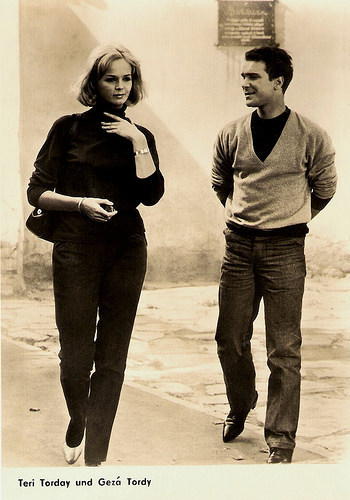
East-German postcard by VEB Progress Filmvertrieb, Berlin, no. 2692, 1966. Photo: publicity still for Ketten haltak meg/Two died (György Palásthy, 1966) with Gezá Tordy.
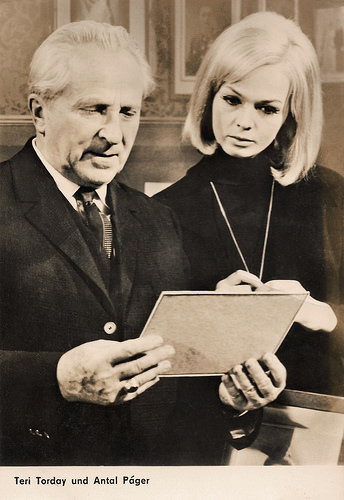
East-German postcard by VEB Progress Filmvertrieb, Berlin, no. 2693, 1966. Photo: publicity still for Ketten haltak meg/Two died (György Palásthy, 1966) with Antal Páger.
The Inspector General
Teri Tordai appeared in several films by noted Hungarian director Márta Mészáros. She had a supporting part in her TV film Anna (Márta Mészáros, 1981) starring Marie-José Nat .
Sh then played Jan Nowicki’s wife in the satirical comedy of errors Délibábok országa/The Inspector General (Márta Mészáros, 1984) based on the play by Nikolai Gogol, and she had a small part in Napló szerelmeimnek/Diary for My Loved Ones (Márta Mészáros, 1987).
She was successful as a grandmother in Mészáros’ Bye bye chaperon rouge/Bye Bye, Red Riding Hood (Márta Mészáros, 1989), and she had small parts in the biographical drama Napló apámnak, anyámnak/Diary for My Father and Mother (Márta Mészáros, 1990) and the drama A magzat/Foetus (Márta Mészáros, 1994).
Also interesting were the surreal comedy Banánhéjkeringö/Banana Skin Waltz (Péter Bacsó, Tamás Tolmár, 1987) and the family comedy Szeleburdi vakáció/Giddy holiday (György Palásthy, 1987). In 1985 she was honoured with the Jászai Mari Award.
In later years, Teri Tordai received only relatively small roles in Hungarian films and television programs. Notable among these films are Ébredés/Awakening (Judit Elek, 1995), Caligula (Sándor Cs. Nagy, 1996) based on the play by Albert Camus, and the musical Hamvadó cigarettavég/Smouldering Cigarette (Péter Bacsó, 2001).
Her daughter Lili Horvath (1976) is also an actress. They appeared together in A temetetlen halott/The Unburied Man (Márta Mészáros, 2004) featuring Jan Nowicki.
Teri Tordai continues to play in Hungarian productions. Most recently she was seen in the romantic drama Kaland/Adventure (József Sipos, 2011) and in the Dutch war film Het Bombardement/The Blitz (Ate de Jong, 2012) with Jan Smit .
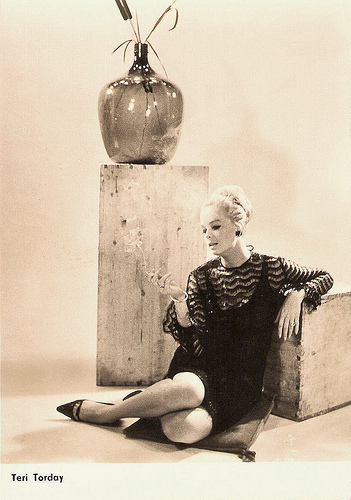
East-German postcard by VEB Progress Filmvertrieb, Berlin, no. 2819, 1967. Retail price: 0,20 MDN. Photo: Hungariafilm.
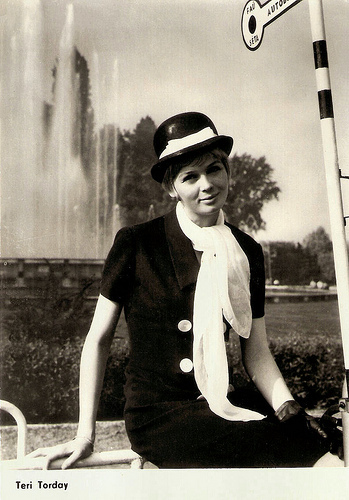
East-German postcard by VEB Progress Filmvertrieb, Berlin, no. 3142, 1968. Photo: Lussa Vince.
German trailer Hurra, wir sind mal wieder Junggesellen/Hurray We Are Bachelors Again (Harald Philipp, 1970). Source: RialtoFilm (YouTube).
Sources: Dr.Štefan ‘Cicis’ Rencz (CSFD.cs - Cszech), Wikipedia (German and Hungarian) and .

East-German postcard by VEB Progress Filmvertrieb, Berlin, no. 2613, 1966. Retail price: 0,20 MDN.

East-German postcard by VEB Progress Filmvertrieb, Berlin, no. 2694, 1966. Retail price: 0,20 MDN.
Sexy Susan
Teri Tordai (also Teri Torday and Terry Torday) was born in Debrecen, Hungary, in 1941.
She received early ballet training and from 1960 on she took acting lessons at the television and film school in Budapest. After graduating in 1964 she played at the National Theatre and the Comedy Theatre.
Already in 1962, she made her first film appearance in the Hungarian film Esös vasárnap/Rainy Sunday (Márton Keleti, 1962). She played one of the leads opposite Gyöngyi Polónyi and Ilona Béres.
In the next years, parts followed in such Hungarian productions as Utolsó elötti ember/The Last But One (Karoly Makk, 1963) and the comedy Mit csinált Felséged 3-tól 5-ig?/What did Sire do between 15 and 17 hour? (Károly Makk, 1964) with Éva Pap and Ildiko Pecso.
She starred opposite Mari Töröcsik in Tilos a szerelem/Forbidden love (Tamás Rényi, 1965).
In 1965 she also made her first German film, the comedy Ferien mit Piroschka/Holiday with Piroschka (Franz Josef Gottlieb, 1965) starring Marie Versini and Götz George . Paradoxically she played a German in Hungary.
Under the name Terry Torday she played title character Susanne in the sexy comedy Susanne, die Wirtin von der Lahn/The Sweet Sins of Sexy Susan (Franz Antel, 1967). The success of this sexy comedy led to a series of six films about the Wirtin von der Lahn (Hostess of the Lahn) all under the direction of Franz Antel.
But she also continued to appear in Hungarian films, including the historical drama Egy magyar nabob/The Hungarian nabob (Zoltán Várkonyi, 1966), and A gyáva/The Coward (Imre Mihályfi, 1971).

East-German postcard by VEB Progress Filmvertrieb, Berlin, no. 2368, 1965. Retail price: 0,20 MDN. Photo: publicity still for Mit csinált Felséged 3-tól 5-ig?/What did Sire do between 15 and 17 hour? (Károly Makk, 1964).

East-German postcard by VEB Progress Filmvertrieb, Berlin, no. 2.555, 1966. Photo: Hungarofilm. Publicity still for Mit csinált Felséged 3-tól 5-ig?/Where Was Your Majesty Between 3 and 5 (Károly Makk, 1964).
Dangerous Temptress
From the 1970s on, Teri Tordai regularly appeared on Hungarian television. Among the TV-films in which she appeared were the romance A vasrács/The iron bars (Tamás Rényi, 1971), Jó estét nyár, jó estét szerelem/A good summer evening, good evening, love (Sándor Szönyi G., 1972) and the Pan-European adventure series Les évasions célèbres/The famous escapes (Christian Jacque a.o., 1972).
An interesting Hungarian film in which she appeared during this period was the adventure film A Pendragon legenda/The Pendragon Legend (György Révész, 1974) with Iván Darvas.
At the time, she appeared in a total of 18 productions for the Austrian film studio Neue Delta. She often played a dangerous temptress, who seduced young men in Monika und die Sechzehnjährigen/Monika and the sixteen-year-old (Charly Steinberger, 1975), Verbrechen nach Schulschluß/Crime after school (Alfred Vohrer, 1975) and very old men like Heinz Rühmann in Der Kapitän/The Captain (Kurt Hoffmann, 1972). Happily, these films could not be shown in her native Hungary, which was a communist state at the time.
More interesting was her work for director István Szabó. Their cooperation started with the TV film Ösbemutató/Opening Night (István Szabó, 1974). She also played the sculptor Lenie in Mephisto (István Szabó, 1981) starring Klaus Maria Brandauer, and the Countess Festetich in Oberst Redl/Colonel Redl (István Szabó, 1985), also featuring Brandauer.
Franz Antel, who had directed her in several sexploitation comedies, also gave her a small part in his interesting war film Der Bockerer (Franz Antel, 1981), the story of Viennese butcher Karl Bockerer (Karl Merkatz) from the moment the Nazis took power in Austria until their end.

East-German postcard by VEB Progress Filmvertrieb, Berlin, no. 2692, 1966. Photo: publicity still for Ketten haltak meg/Two died (György Palásthy, 1966) with Gezá Tordy.

East-German postcard by VEB Progress Filmvertrieb, Berlin, no. 2693, 1966. Photo: publicity still for Ketten haltak meg/Two died (György Palásthy, 1966) with Antal Páger.
The Inspector General
Teri Tordai appeared in several films by noted Hungarian director Márta Mészáros. She had a supporting part in her TV film Anna (Márta Mészáros, 1981) starring Marie-José Nat .
Sh then played Jan Nowicki’s wife in the satirical comedy of errors Délibábok országa/The Inspector General (Márta Mészáros, 1984) based on the play by Nikolai Gogol, and she had a small part in Napló szerelmeimnek/Diary for My Loved Ones (Márta Mészáros, 1987).
She was successful as a grandmother in Mészáros’ Bye bye chaperon rouge/Bye Bye, Red Riding Hood (Márta Mészáros, 1989), and she had small parts in the biographical drama Napló apámnak, anyámnak/Diary for My Father and Mother (Márta Mészáros, 1990) and the drama A magzat/Foetus (Márta Mészáros, 1994).
Also interesting were the surreal comedy Banánhéjkeringö/Banana Skin Waltz (Péter Bacsó, Tamás Tolmár, 1987) and the family comedy Szeleburdi vakáció/Giddy holiday (György Palásthy, 1987). In 1985 she was honoured with the Jászai Mari Award.
In later years, Teri Tordai received only relatively small roles in Hungarian films and television programs. Notable among these films are Ébredés/Awakening (Judit Elek, 1995), Caligula (Sándor Cs. Nagy, 1996) based on the play by Albert Camus, and the musical Hamvadó cigarettavég/Smouldering Cigarette (Péter Bacsó, 2001).
Her daughter Lili Horvath (1976) is also an actress. They appeared together in A temetetlen halott/The Unburied Man (Márta Mészáros, 2004) featuring Jan Nowicki.
Teri Tordai continues to play in Hungarian productions. Most recently she was seen in the romantic drama Kaland/Adventure (József Sipos, 2011) and in the Dutch war film Het Bombardement/The Blitz (Ate de Jong, 2012) with Jan Smit .

East-German postcard by VEB Progress Filmvertrieb, Berlin, no. 2819, 1967. Retail price: 0,20 MDN. Photo: Hungariafilm.

East-German postcard by VEB Progress Filmvertrieb, Berlin, no. 3142, 1968. Photo: Lussa Vince.
German trailer Hurra, wir sind mal wieder Junggesellen/Hurray We Are Bachelors Again (Harald Philipp, 1970). Source: RialtoFilm (YouTube).
Sources: Dr.Štefan ‘Cicis’ Rencz (CSFD.cs - Cszech), Wikipedia (German and Hungarian) and .
Published on August 30, 2018 22:00
August 29, 2018
Ein Walzertraum (1925)
Willy Fritsch, Mady Christians and Xenia Desni were the stars in the German silent Ufa production Ein Walzertraum/The Waltz Dream (Ludwig Berger, 1925), based on the Oscar Strauss operetta. The success of the film lead to a wave of operetta films in Germany and Austria, andf paved the way to Hollywood for director Ludwig Berger.
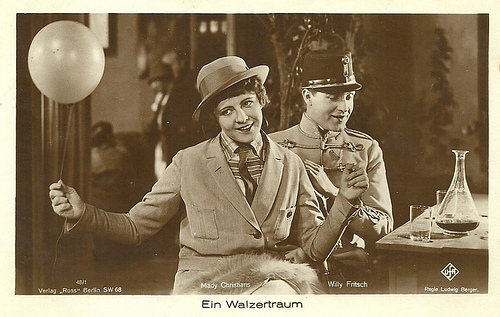
German postcard by Ross Verlag, no. 48/1. Mady Christians and Willy Fritsch in the Ufa-film Ein Walzertraum (Ludwig Berger, 1925).
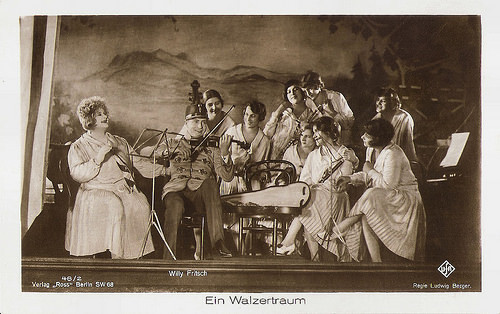
German postcard by Ross Verlag, no. 48/2. Photo: Ufa. Lydia Potechina (left) and Willy Fritsch in Ein Walzertraum/The Waltz Dream (Ludwig Berger, 1925).
An international successful operetta
Originally, Ein Walzertraum/A Waltz Dream was one of the best known operettas by Oscar Straus, a Viennese composer of operettas and film scores and songs. The German libretto was by Leopold Jacobson and Felix Dörmann, based on the novella Nux, der Prinzgemahl (Nux, the Prince Consort) by Hans Müller-Einigen from his 1905 book Buch der Abenteuer (Book of Adventures).
The young Jacobson presented Oscar Straus with a libretto for Ein Walzertraum at a coffee house in the Vienna Prater in 1906. Straus was inspired by the text and completed the work within 12 months. Ein Walzertraum premiered on 2 March 1907 at the Carltheater in Vienna.
Following the success of the operetta in Vienna, productions of the work, under the name A Waltz Dream, were mounted in English for premieres at the Chestnut Street Opera House in Philadelphia on 6 January 1908, in New York City at the now-demolished Broadway Theatre on 27 January 1908 (with an English libretto adapted by Joseph Herbert), and in London on 28 March 1908 at the Hicks Theatre (adapted by Basil Hood, with lyrics by Adrian Ross, starring Gertie Millar and W.H. Berry). Lily Elsie and Amy Evans starred in the 1911 revival at Daly's Theatre.
The international success of the operetta exceeded Straus's expectations, and special praise was reserved for the famous waltz theme from Act Two. Straus later arranged various numbers from the operetta and included the graceful main waltz theme into a new concert waltz. The piece made Straus's international reputation, touring internationally after the Vienna, New York and London runs and enjoying many revivals.
The operetta did not remain as popular over the decades as Straus' The Chocolate Soldier, but a number of modern productions have been mounted. In 1991, Ohio Light Opera produced the work, and in 1992, Light Opera Works of Illinois mounted a production.
Film versions of the operetta include the Hungarian silent film Varázskeringö/Magic Waltz (1918) directed by Michael Curtiz, the German film Ein Walzertraum/The Waltz Dream (1925) directed by Ludwig Berger, and releases in Finland (1926) and Poland (1931). Ernst Lubitsch made the best known film version, The Smiling Lieutenant (1931), starring Maurice Chevalier and Claudette Colbert.
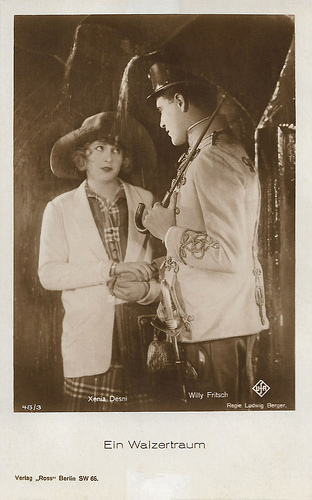
German postcard by Ross Verlag, no. 48/3. Photo: Ufa. Xenia Desni and Willy Fritsch in Ein Walzertraum/The Waltz Dream (Ludwig Berger, 1925).
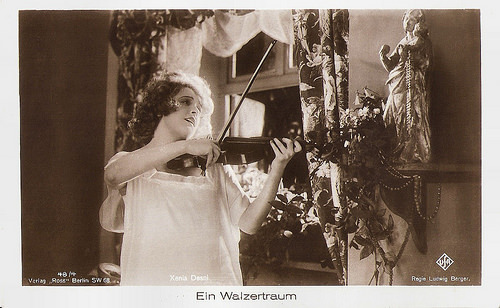
German postcard by Ross Verlag, no. 48/4. Photo: Ufa. Xenia Desni in Ein Walzertraum/The Waltz Dream (Ludwig Berger, 1925).
The amorous lieutenant and the princess
Erich Pommer produced for the Ufa a wonderful silent film version of the operetta, Ein Walzertraum/The Waltz Dream (Ludwig Berger, 1925), with a great cast and fine exterior shots at the famous Imperial Schloss Schönbrunn.
Sunnyboy Willy Fritsch plays the amorous lieutenant Nicholas Count Preyn of the Austrian royal guard. 'Niki' has a new girlfriend, the violin playing Franzi Steingruber (Xenia Desni). He's crazy about her and is smiling at her while on duty in the street. King Eberhard XXIII (Jacob Tiedtke) and his daughter Princess Alix ( Mady Christians ) from the neighboring kingdom of Flausenthurm drive by, and Alix intercepts a wink meant for Franzi.
The princess falls for Niki, marries him (he has no choice in the matter), and whisks him off to Flausenthurm. Franzi follows and enjoys a brief affair with Niki before Anna finds out. Franzi, much more experienced in the ways of the world, gives the socially awkward princess Alix lessons on how to win the affections of her husband.
The cast of Ein Walzertraum/The Waltz Dream also included such great character actors as Lydia Potechina, Mathilde Sussin, Karl Beckersachs , Julius Falkenstein, Hans Brausewetter and Lucie Höflich. The film was a great box office hit but also a critical success. For director Ludwig Berger, Ein Walzertraum/The Waltz Dream brought an invitation to Hollywood.
In Germany, Ein Walzertraum/The Waltz Dream lead to a wave of silent operetta and Vienna films. In the sound era, this genre culminated in the world hit Der Kongress tanzt/The Congress dances (Erik Charell, 1931) with Lilian Harvey and of course Willy Fritsch .
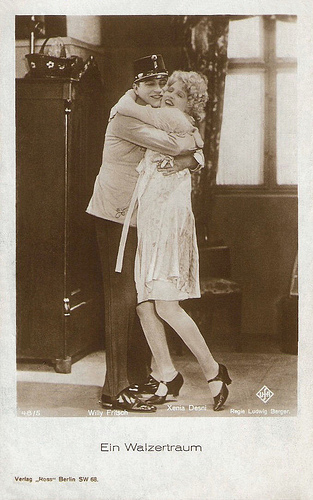
German postcard by Ross Verlag, no. 48/5. Photo: Ufa. Publicity still for Ein Walzertraum/The Waltz Dream (Ludwig Berger, 1925) with Xenia Desni and Willy Fritsch .
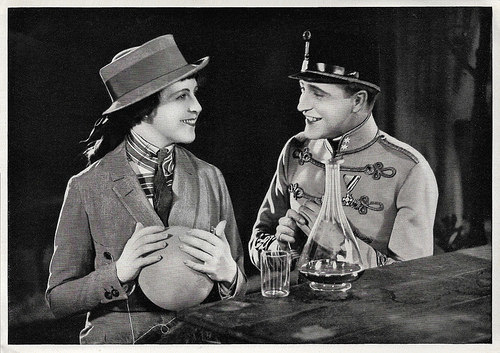
German collectors card by Ross Verlag in the series Vom Werden deutscher Filmkunst - Der Stumme Film, picture no. 115, group 40. Photo: Ufa. Publicity still for Ein Walzertraum/A Waltz-Dream (Ludwig Berger, 1925) with Mady Christians and Willy Fritsch .
Sources: Wikipedia (English and German), and IMDb.

German postcard by Ross Verlag, no. 48/1. Mady Christians and Willy Fritsch in the Ufa-film Ein Walzertraum (Ludwig Berger, 1925).

German postcard by Ross Verlag, no. 48/2. Photo: Ufa. Lydia Potechina (left) and Willy Fritsch in Ein Walzertraum/The Waltz Dream (Ludwig Berger, 1925).
An international successful operetta
Originally, Ein Walzertraum/A Waltz Dream was one of the best known operettas by Oscar Straus, a Viennese composer of operettas and film scores and songs. The German libretto was by Leopold Jacobson and Felix Dörmann, based on the novella Nux, der Prinzgemahl (Nux, the Prince Consort) by Hans Müller-Einigen from his 1905 book Buch der Abenteuer (Book of Adventures).
The young Jacobson presented Oscar Straus with a libretto for Ein Walzertraum at a coffee house in the Vienna Prater in 1906. Straus was inspired by the text and completed the work within 12 months. Ein Walzertraum premiered on 2 March 1907 at the Carltheater in Vienna.
Following the success of the operetta in Vienna, productions of the work, under the name A Waltz Dream, were mounted in English for premieres at the Chestnut Street Opera House in Philadelphia on 6 January 1908, in New York City at the now-demolished Broadway Theatre on 27 January 1908 (with an English libretto adapted by Joseph Herbert), and in London on 28 March 1908 at the Hicks Theatre (adapted by Basil Hood, with lyrics by Adrian Ross, starring Gertie Millar and W.H. Berry). Lily Elsie and Amy Evans starred in the 1911 revival at Daly's Theatre.
The international success of the operetta exceeded Straus's expectations, and special praise was reserved for the famous waltz theme from Act Two. Straus later arranged various numbers from the operetta and included the graceful main waltz theme into a new concert waltz. The piece made Straus's international reputation, touring internationally after the Vienna, New York and London runs and enjoying many revivals.
The operetta did not remain as popular over the decades as Straus' The Chocolate Soldier, but a number of modern productions have been mounted. In 1991, Ohio Light Opera produced the work, and in 1992, Light Opera Works of Illinois mounted a production.
Film versions of the operetta include the Hungarian silent film Varázskeringö/Magic Waltz (1918) directed by Michael Curtiz, the German film Ein Walzertraum/The Waltz Dream (1925) directed by Ludwig Berger, and releases in Finland (1926) and Poland (1931). Ernst Lubitsch made the best known film version, The Smiling Lieutenant (1931), starring Maurice Chevalier and Claudette Colbert.

German postcard by Ross Verlag, no. 48/3. Photo: Ufa. Xenia Desni and Willy Fritsch in Ein Walzertraum/The Waltz Dream (Ludwig Berger, 1925).

German postcard by Ross Verlag, no. 48/4. Photo: Ufa. Xenia Desni in Ein Walzertraum/The Waltz Dream (Ludwig Berger, 1925).
The amorous lieutenant and the princess
Erich Pommer produced for the Ufa a wonderful silent film version of the operetta, Ein Walzertraum/The Waltz Dream (Ludwig Berger, 1925), with a great cast and fine exterior shots at the famous Imperial Schloss Schönbrunn.
Sunnyboy Willy Fritsch plays the amorous lieutenant Nicholas Count Preyn of the Austrian royal guard. 'Niki' has a new girlfriend, the violin playing Franzi Steingruber (Xenia Desni). He's crazy about her and is smiling at her while on duty in the street. King Eberhard XXIII (Jacob Tiedtke) and his daughter Princess Alix ( Mady Christians ) from the neighboring kingdom of Flausenthurm drive by, and Alix intercepts a wink meant for Franzi.
The princess falls for Niki, marries him (he has no choice in the matter), and whisks him off to Flausenthurm. Franzi follows and enjoys a brief affair with Niki before Anna finds out. Franzi, much more experienced in the ways of the world, gives the socially awkward princess Alix lessons on how to win the affections of her husband.
The cast of Ein Walzertraum/The Waltz Dream also included such great character actors as Lydia Potechina, Mathilde Sussin, Karl Beckersachs , Julius Falkenstein, Hans Brausewetter and Lucie Höflich. The film was a great box office hit but also a critical success. For director Ludwig Berger, Ein Walzertraum/The Waltz Dream brought an invitation to Hollywood.
In Germany, Ein Walzertraum/The Waltz Dream lead to a wave of silent operetta and Vienna films. In the sound era, this genre culminated in the world hit Der Kongress tanzt/The Congress dances (Erik Charell, 1931) with Lilian Harvey and of course Willy Fritsch .

German postcard by Ross Verlag, no. 48/5. Photo: Ufa. Publicity still for Ein Walzertraum/The Waltz Dream (Ludwig Berger, 1925) with Xenia Desni and Willy Fritsch .

German collectors card by Ross Verlag in the series Vom Werden deutscher Filmkunst - Der Stumme Film, picture no. 115, group 40. Photo: Ufa. Publicity still for Ein Walzertraum/A Waltz-Dream (Ludwig Berger, 1925) with Mady Christians and Willy Fritsch .
Sources: Wikipedia (English and German), and IMDb.
Published on August 29, 2018 22:00
Paul van Yperen's Blog
- Paul van Yperen's profile
- 13 followers
Paul van Yperen isn't a Goodreads Author
(yet),
but they
do have a blog,
so here are some recent posts imported from
their feed.



